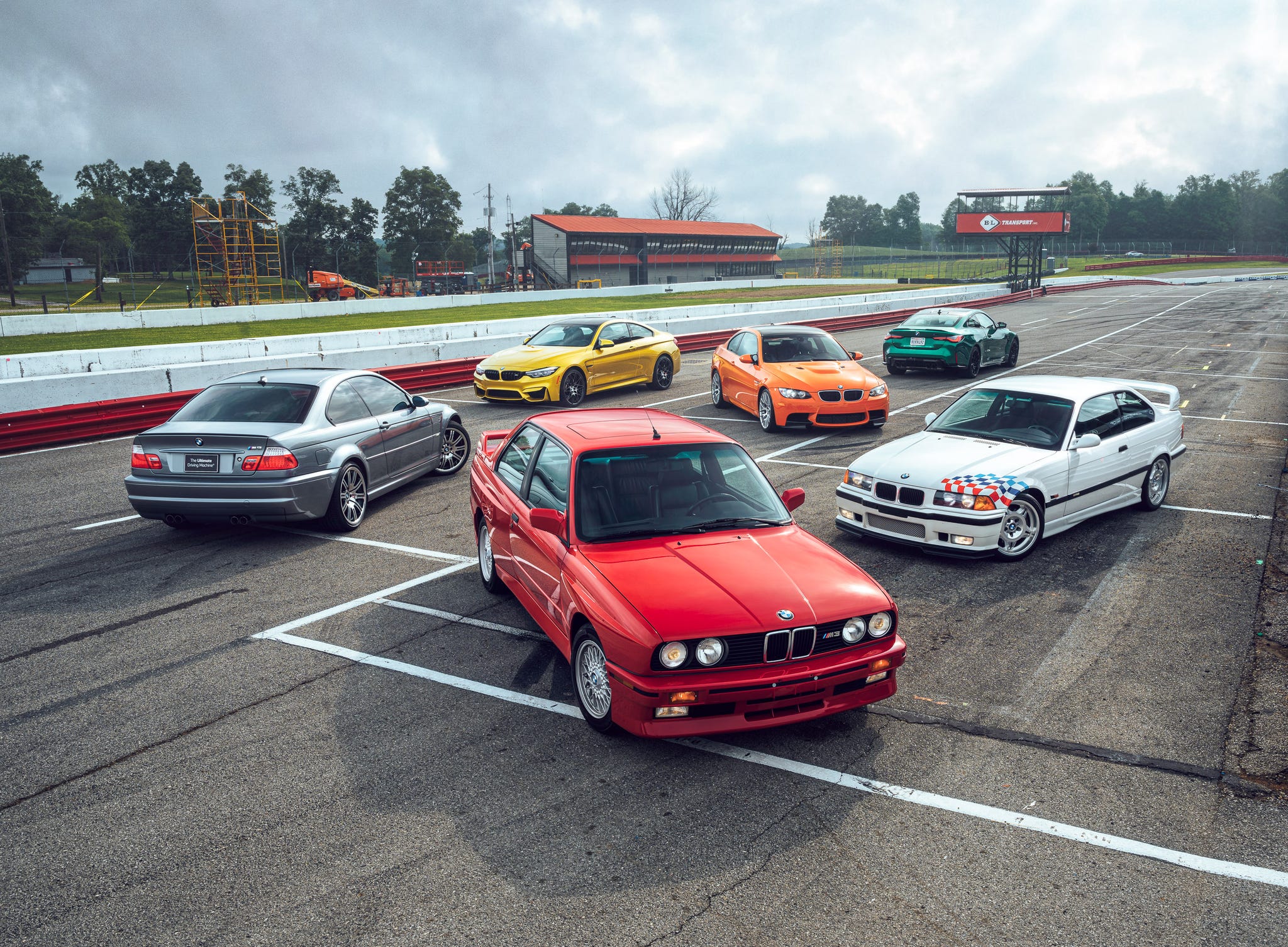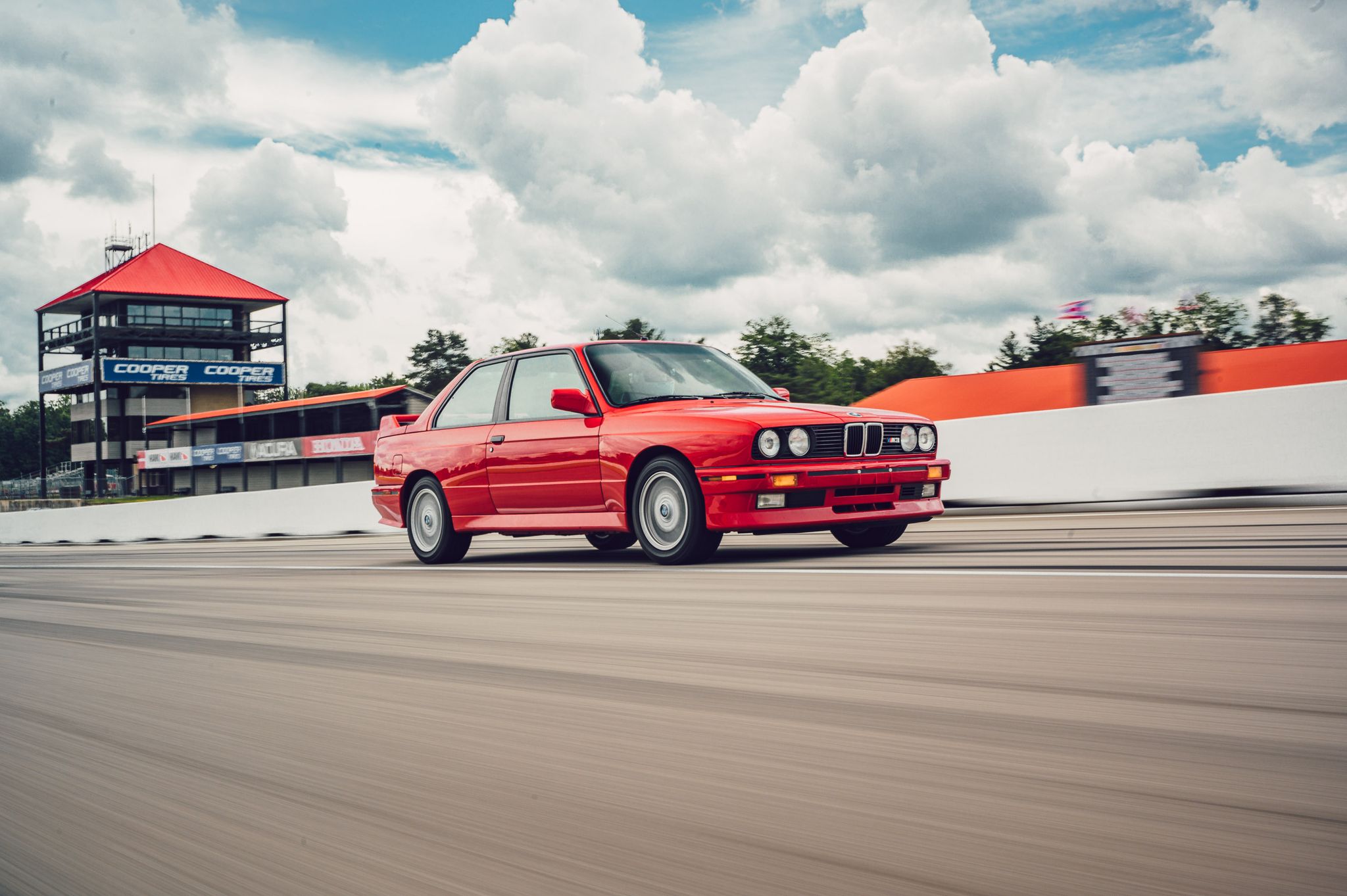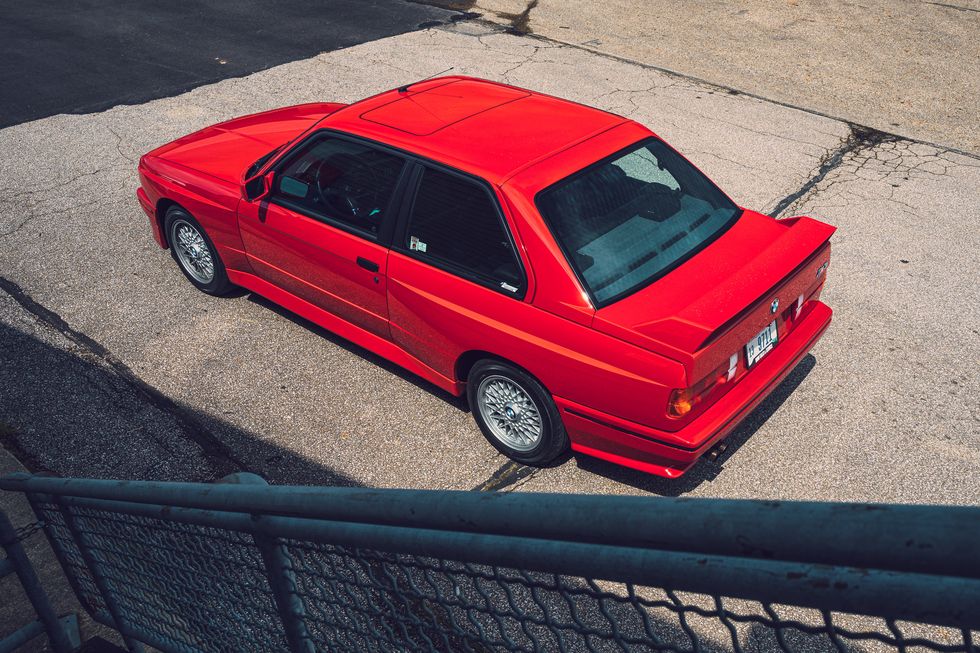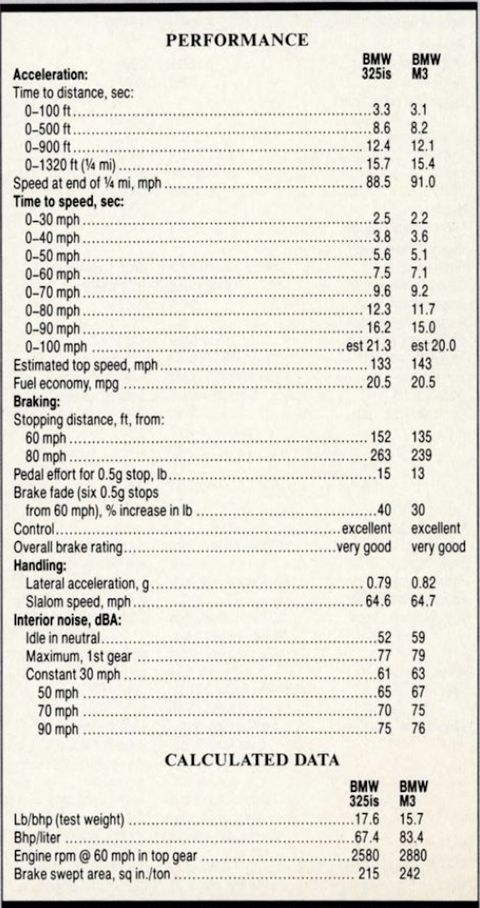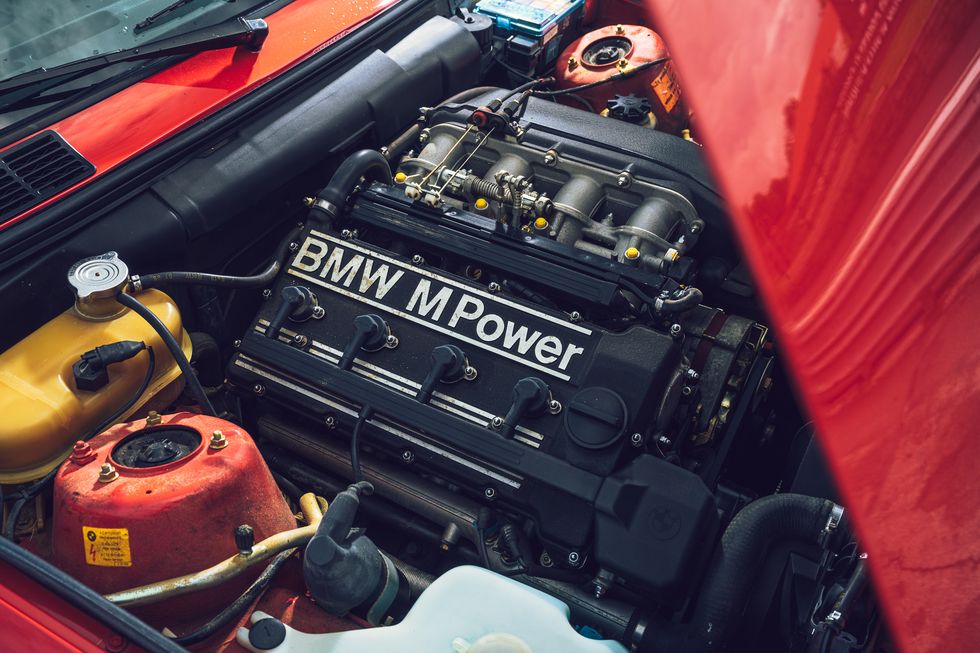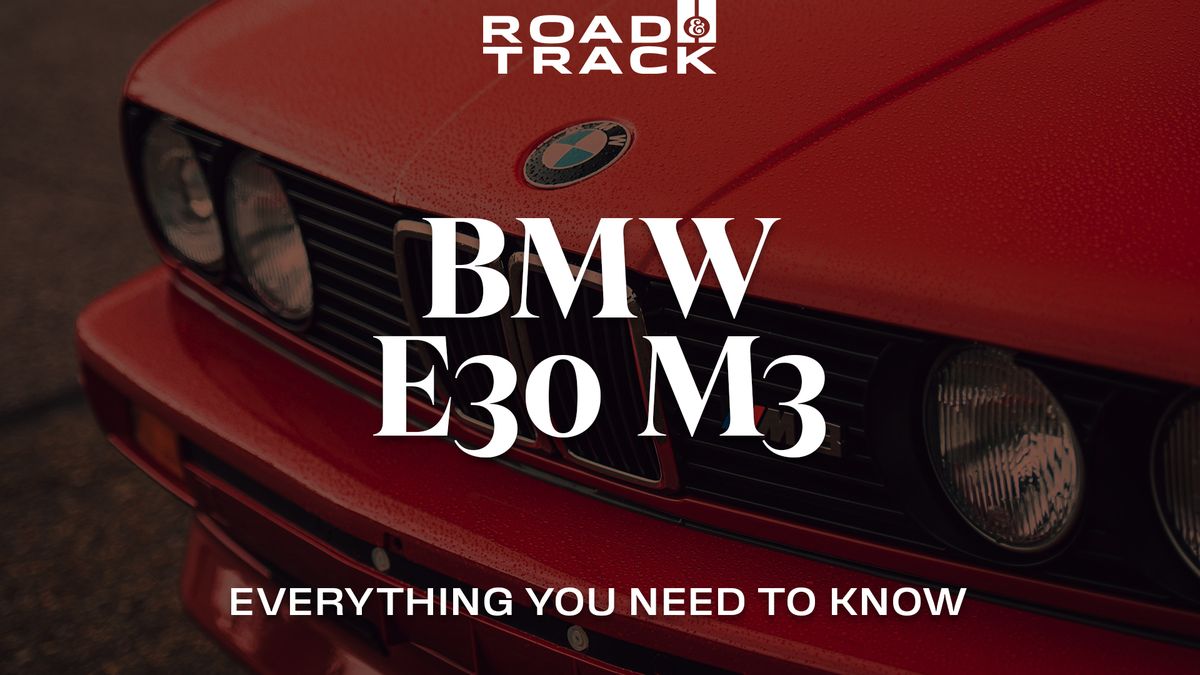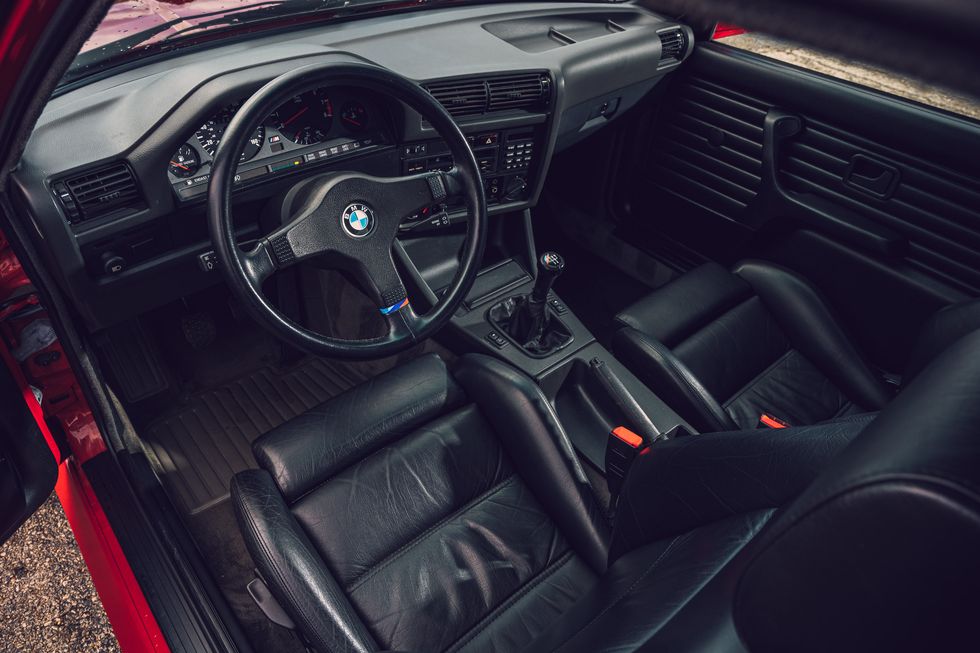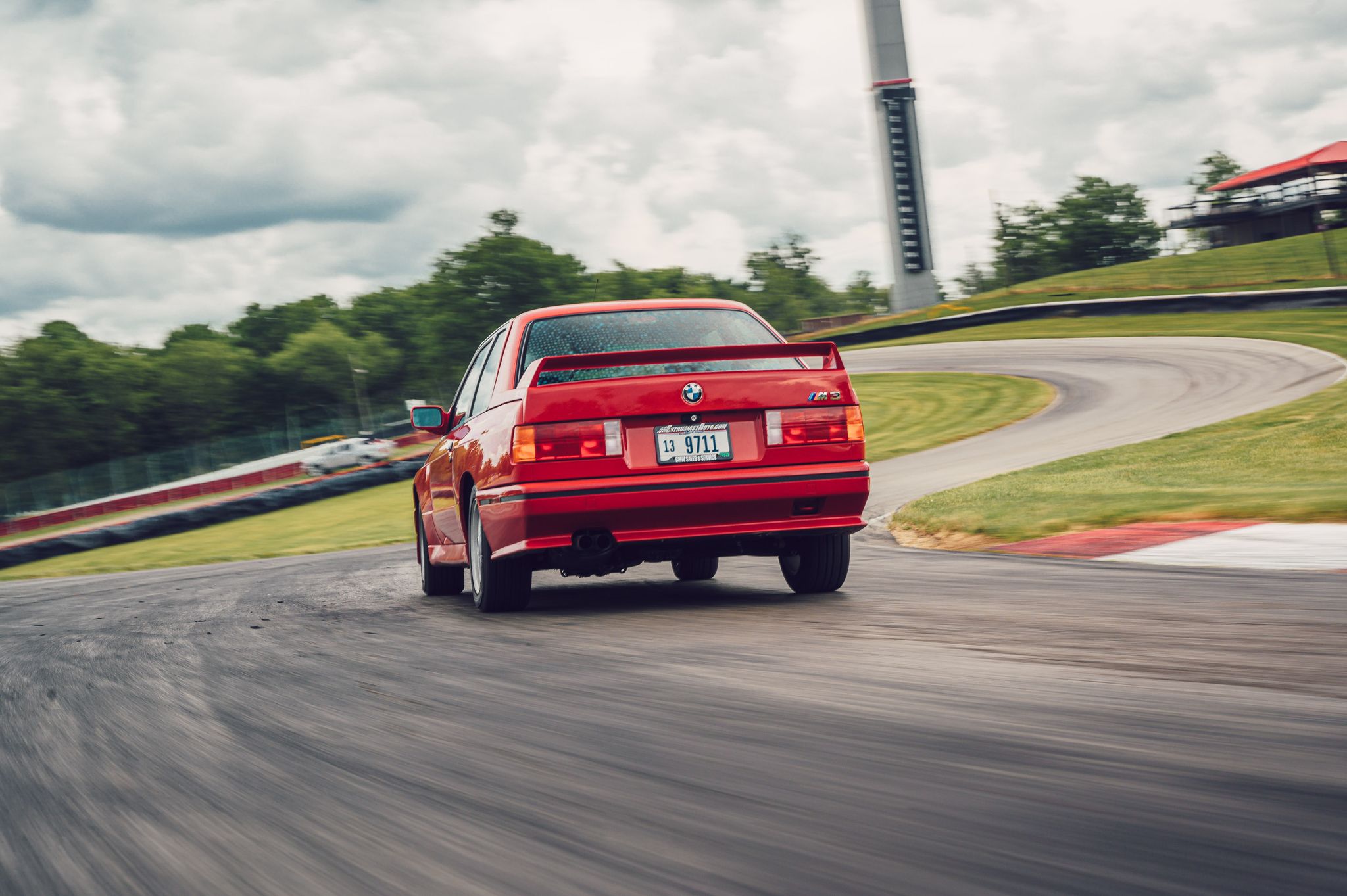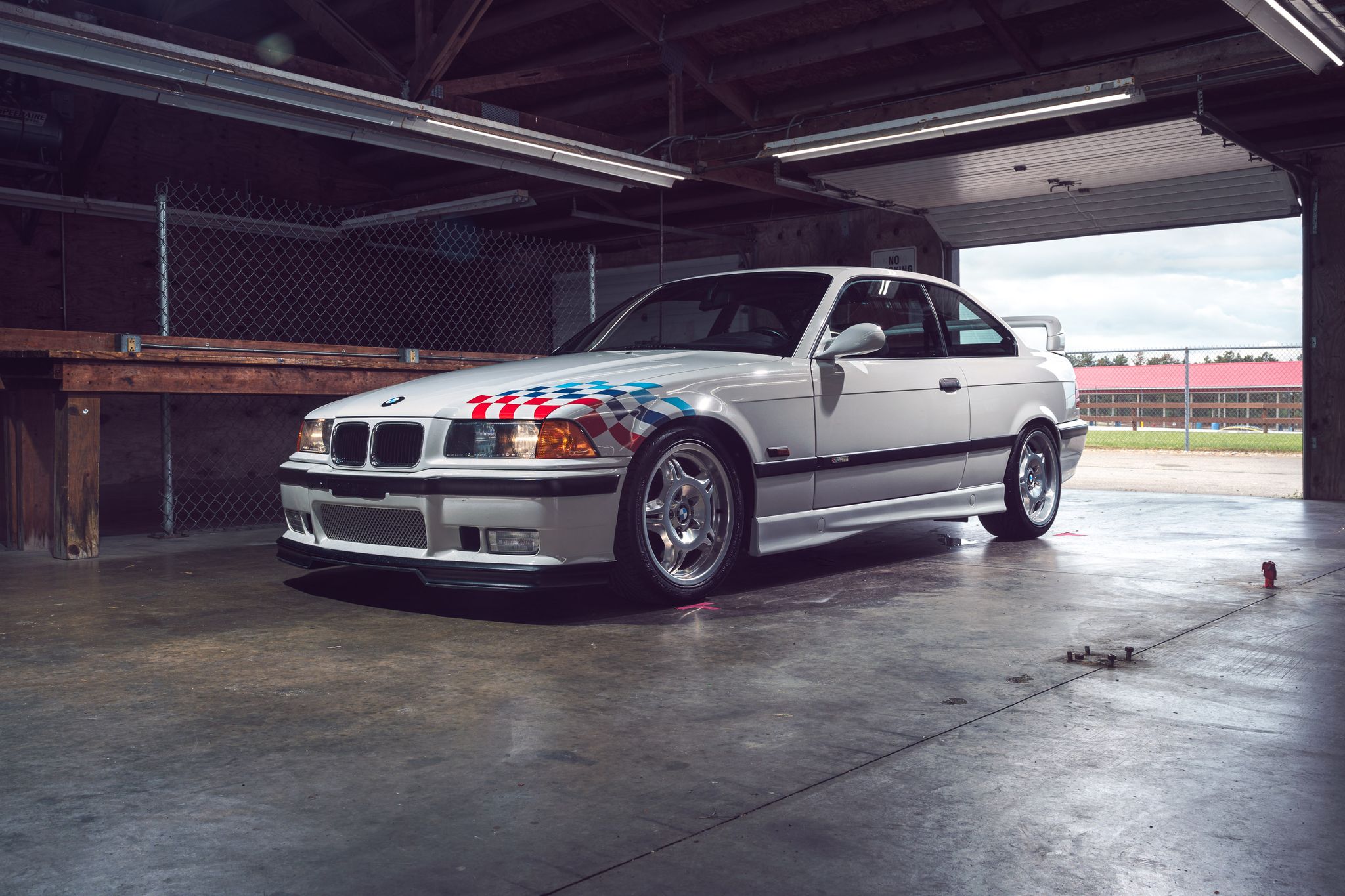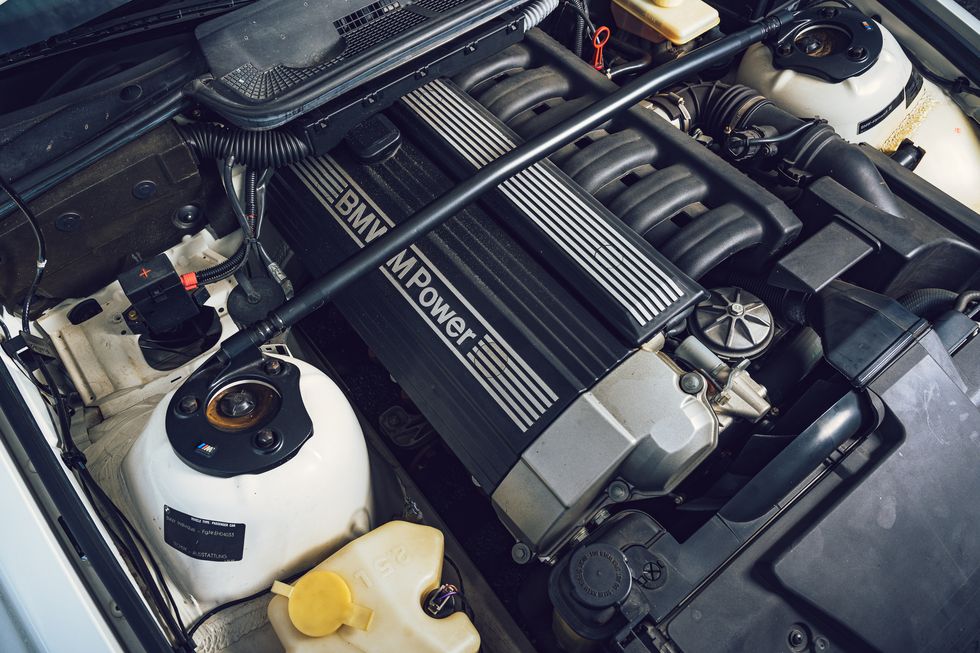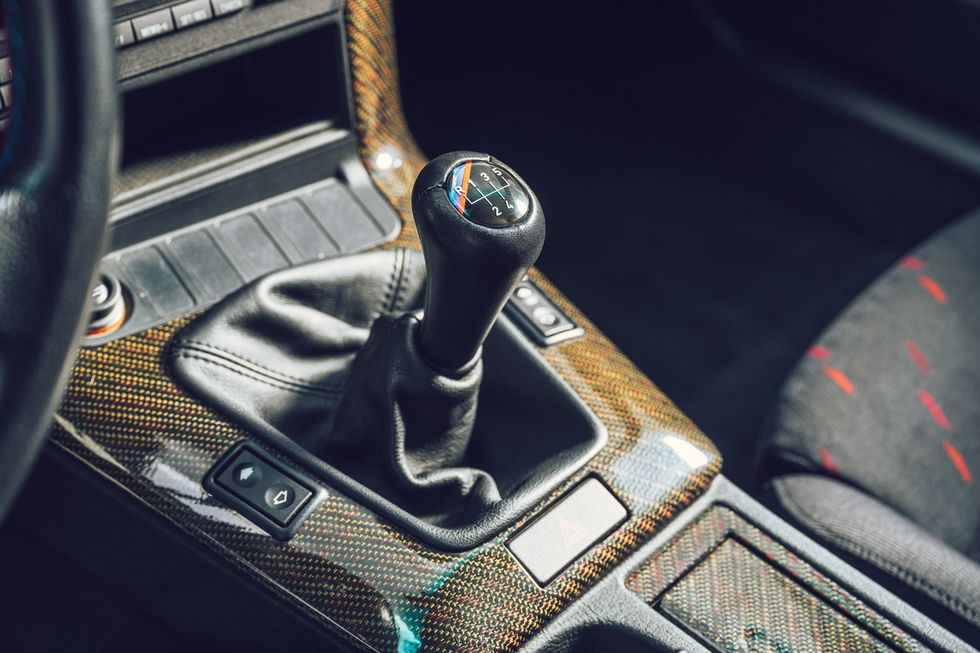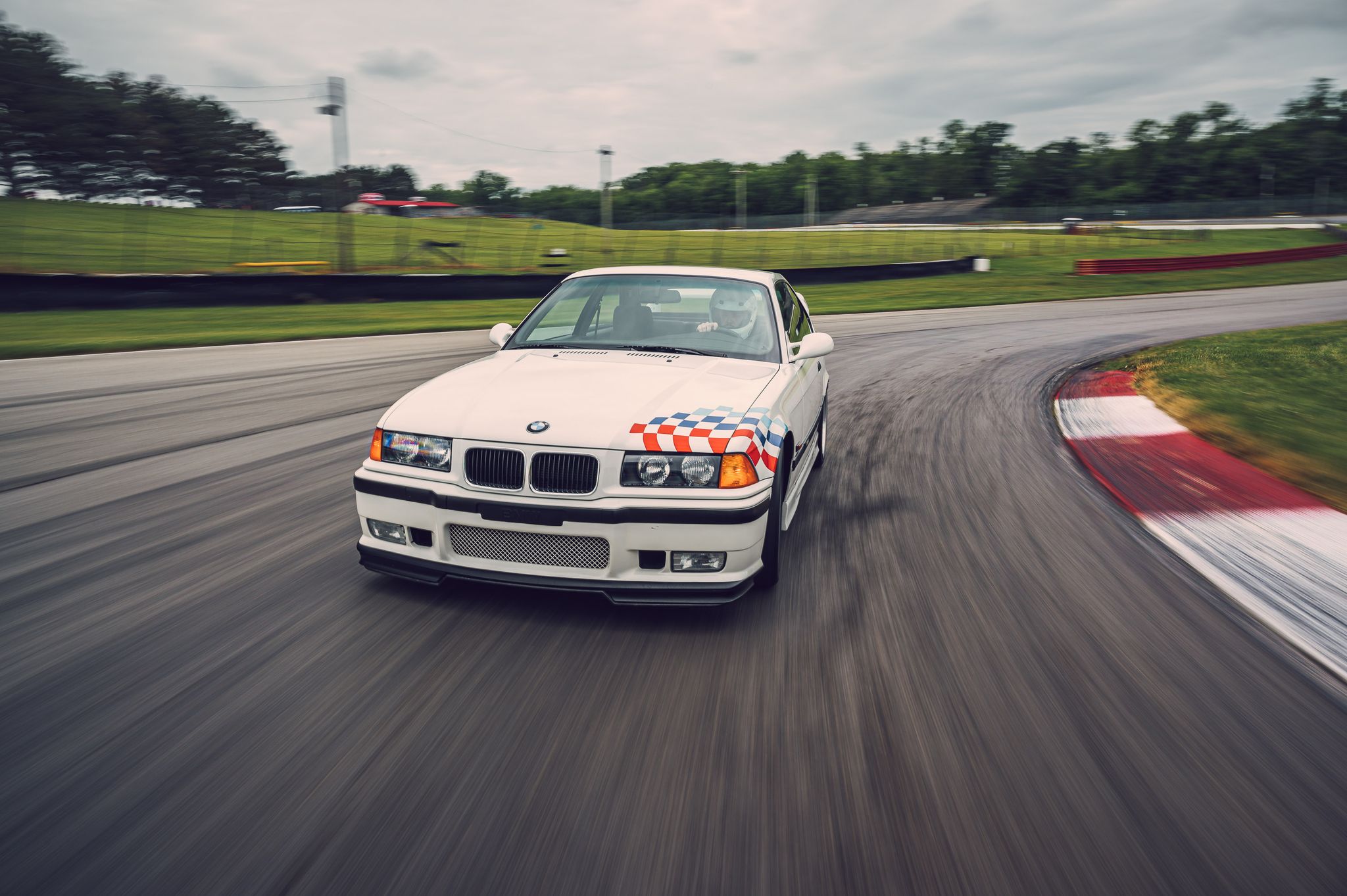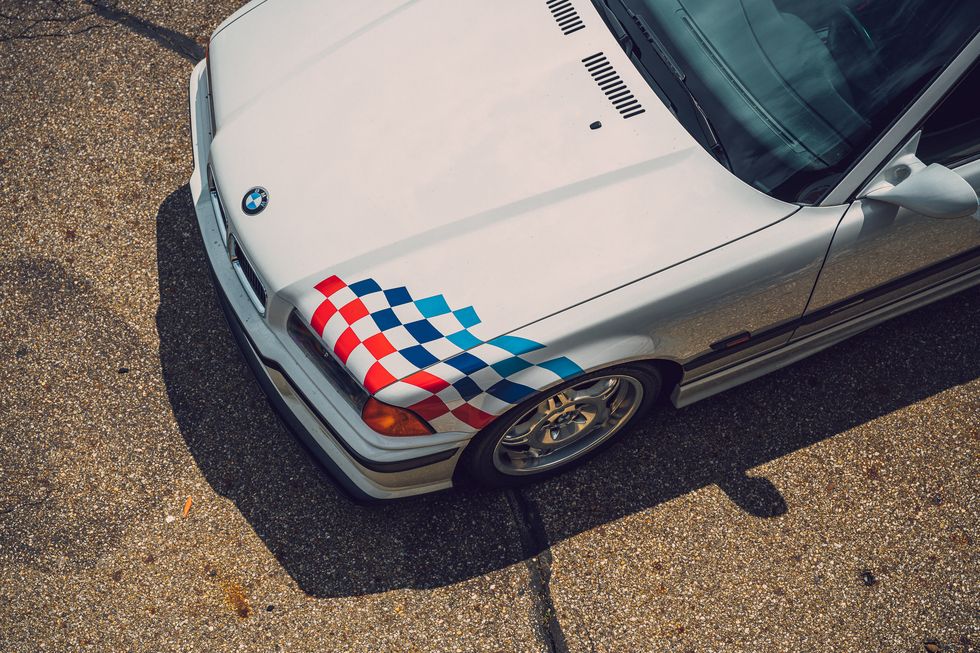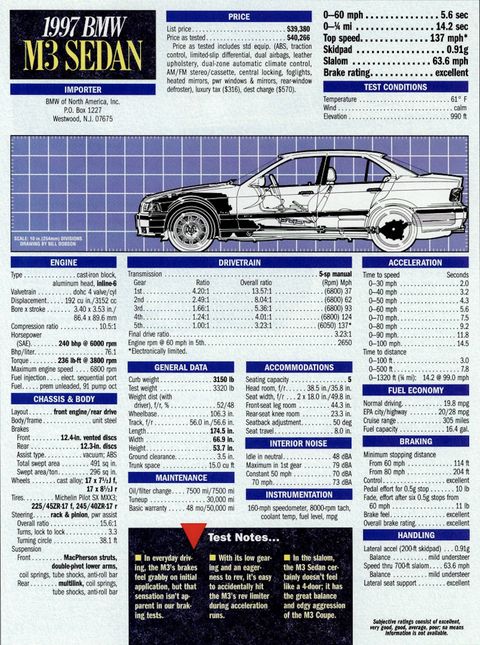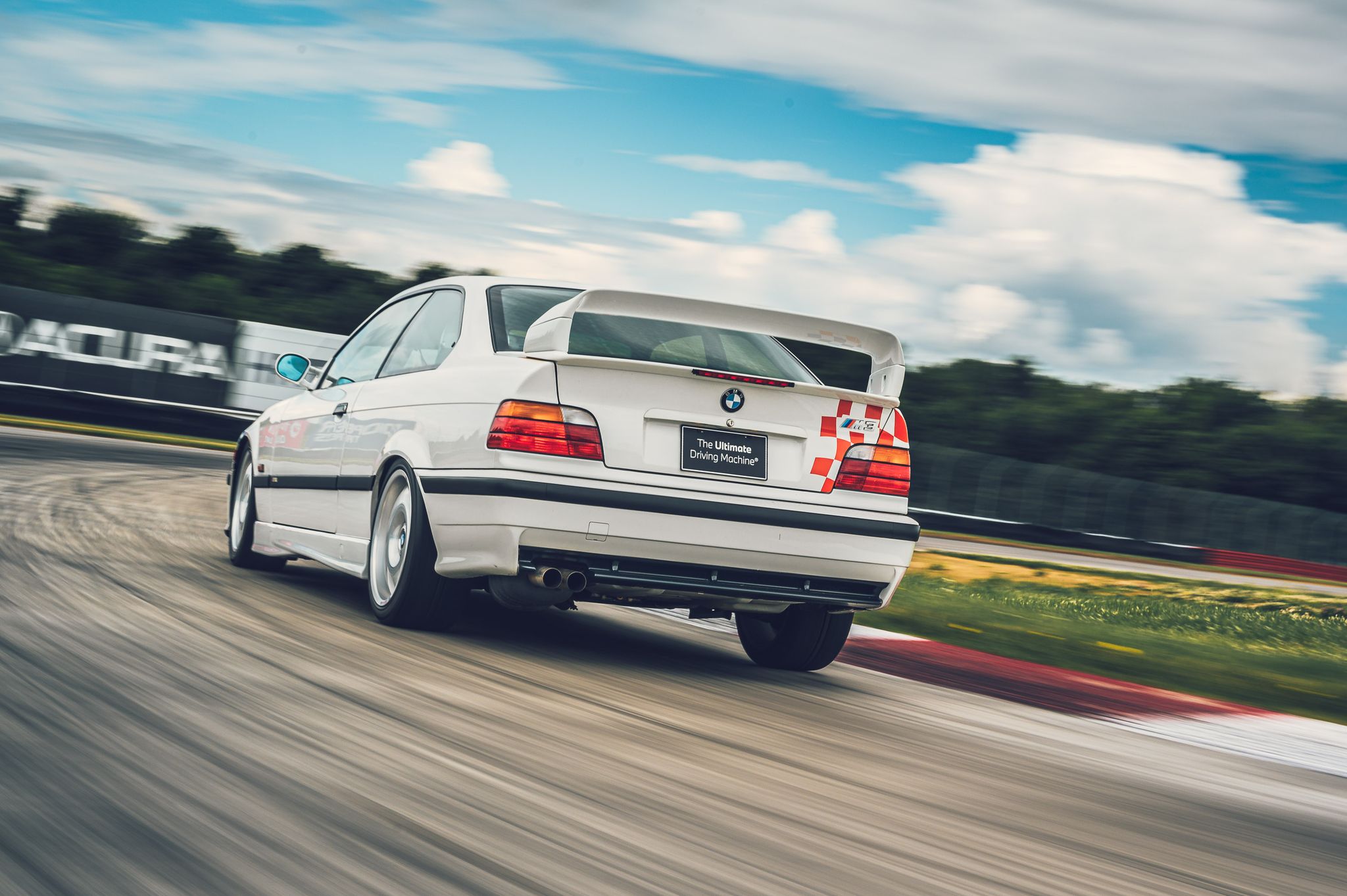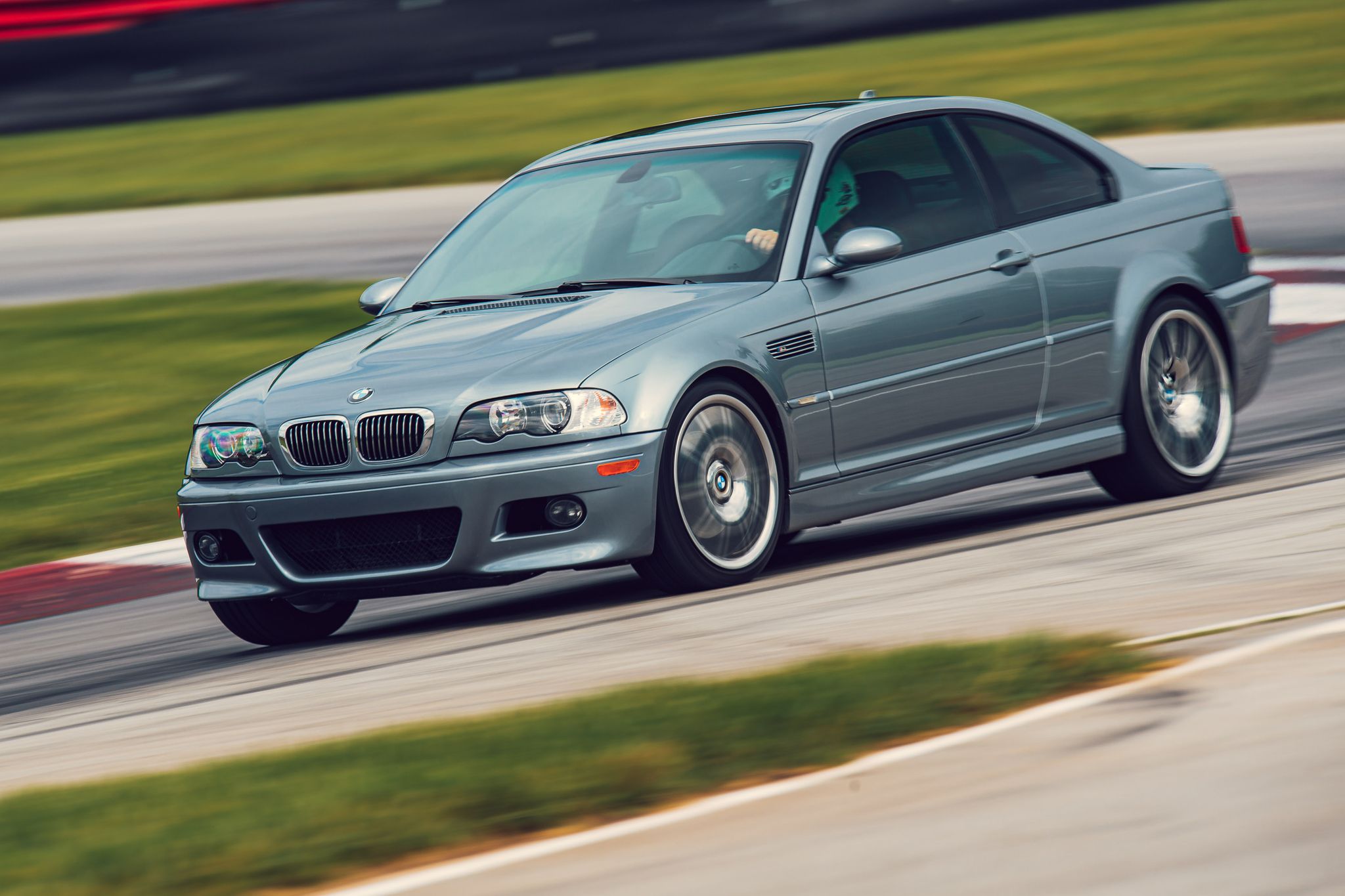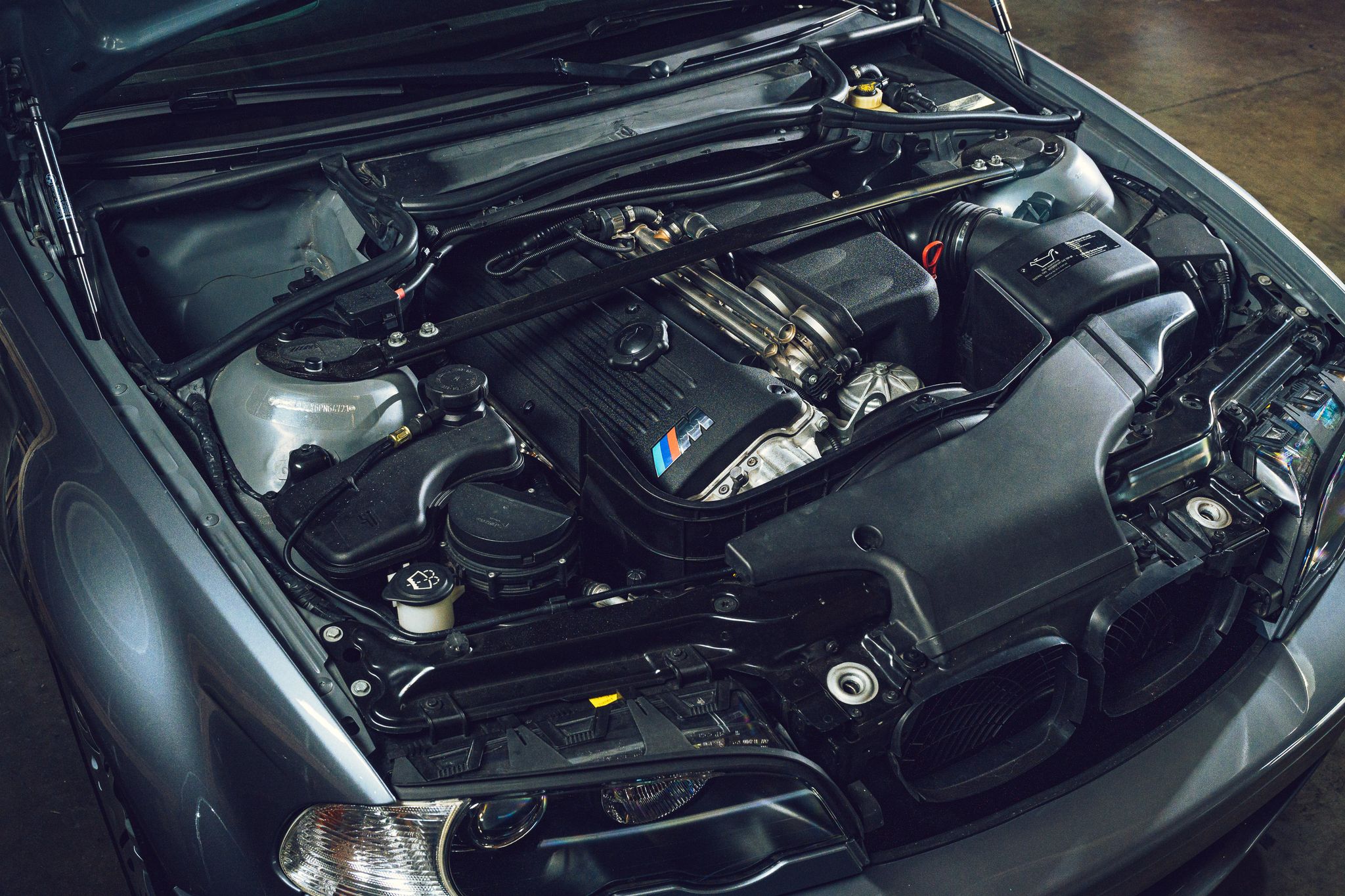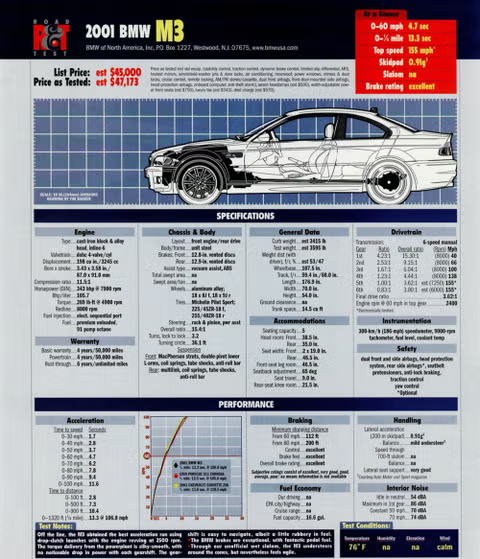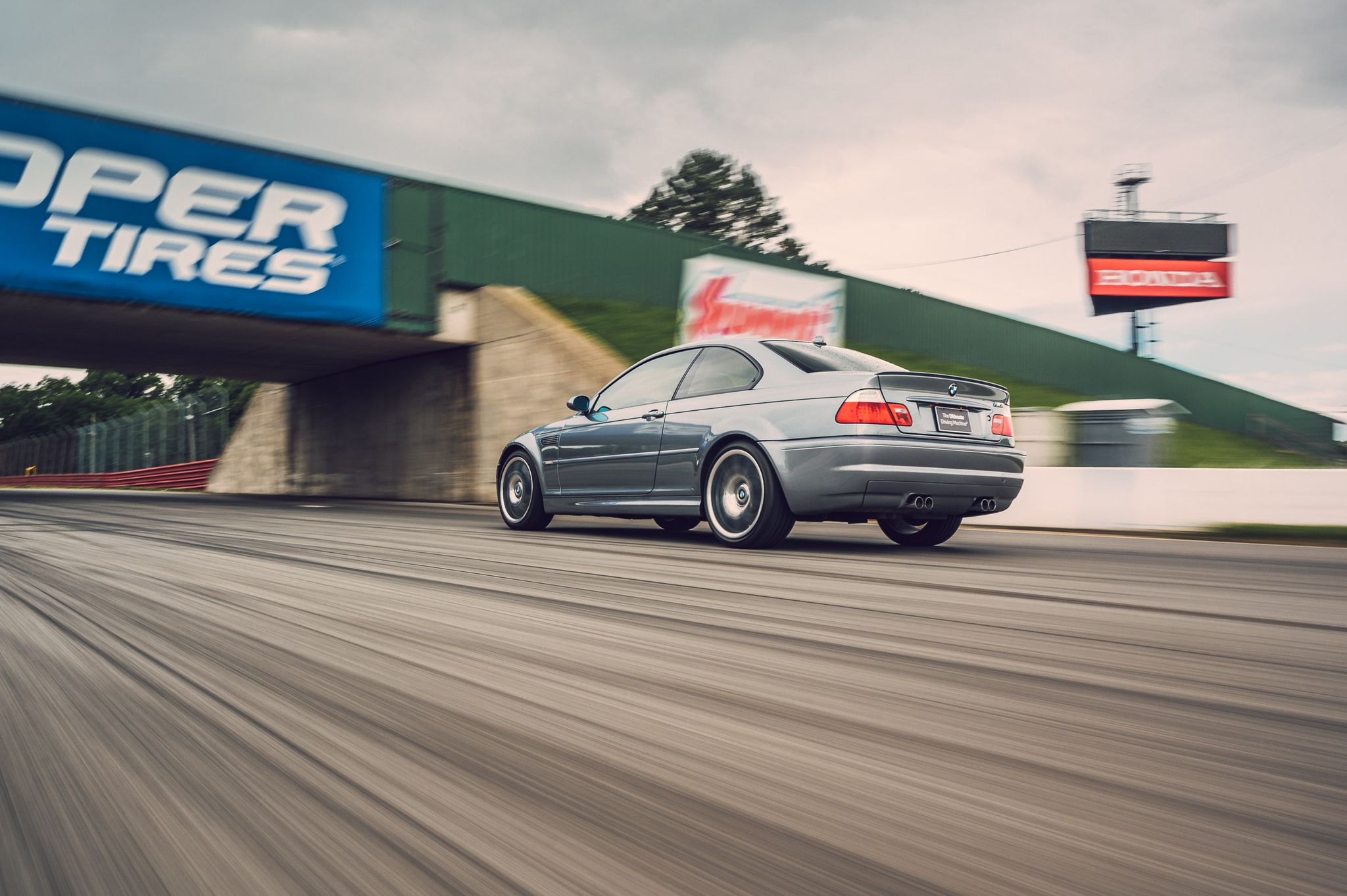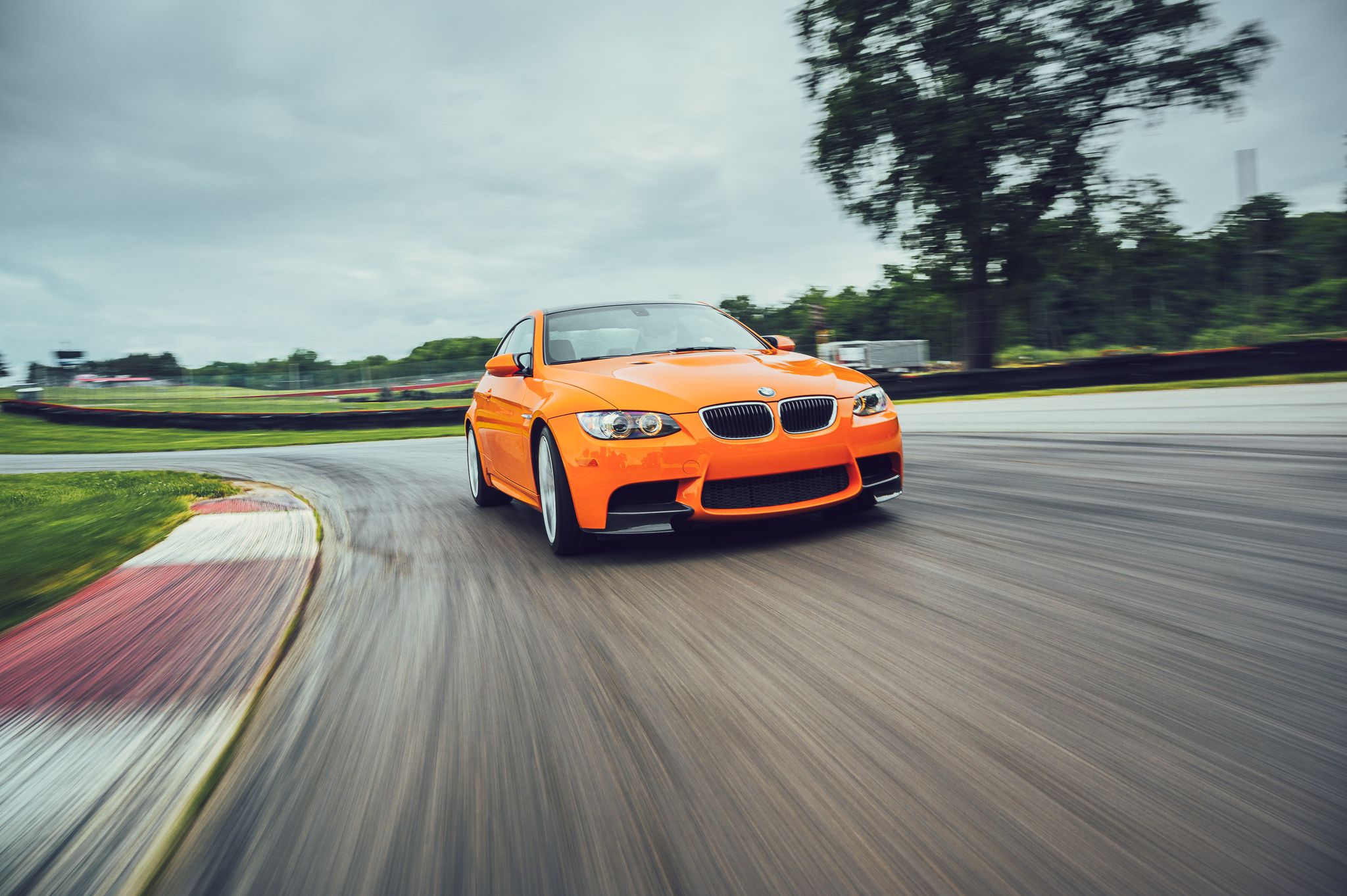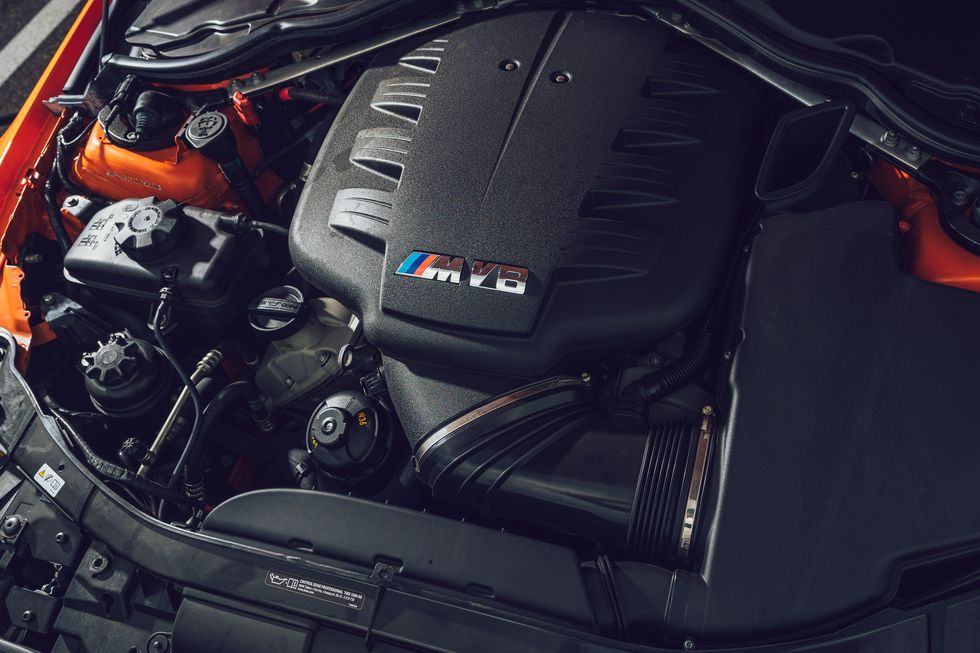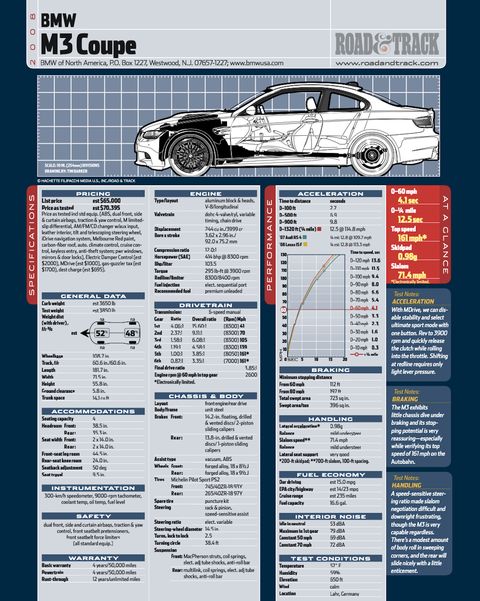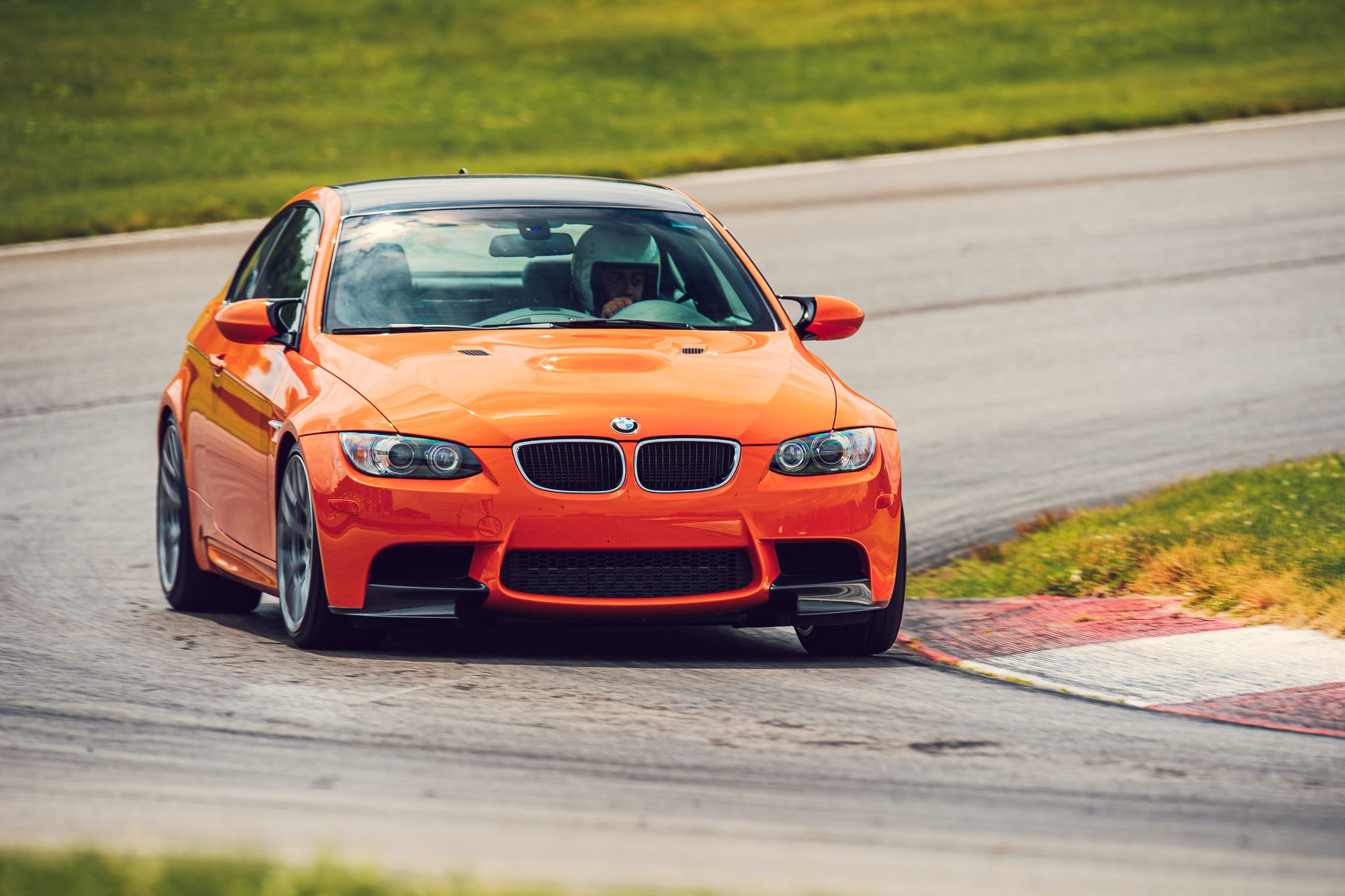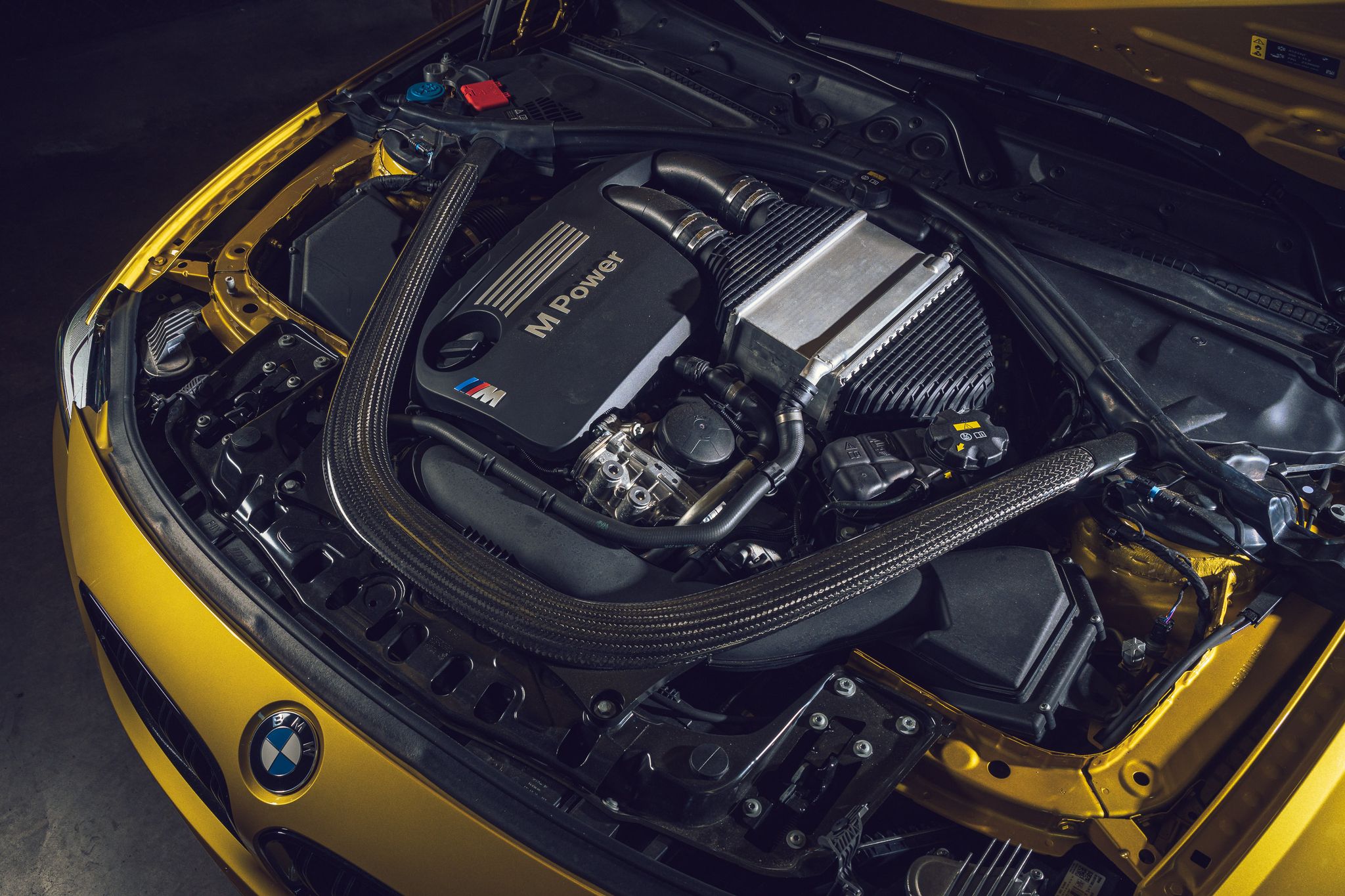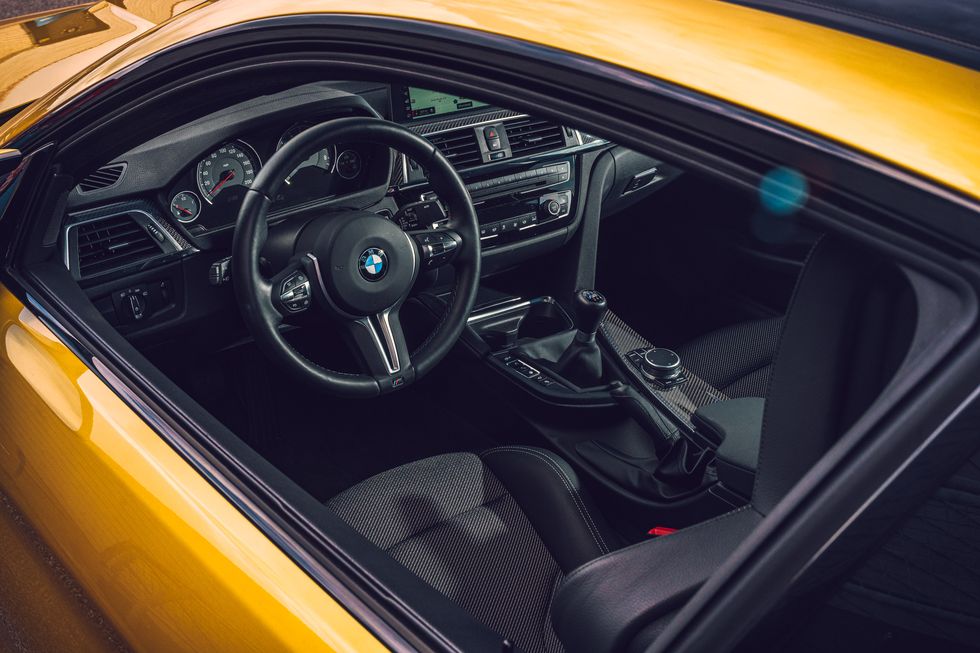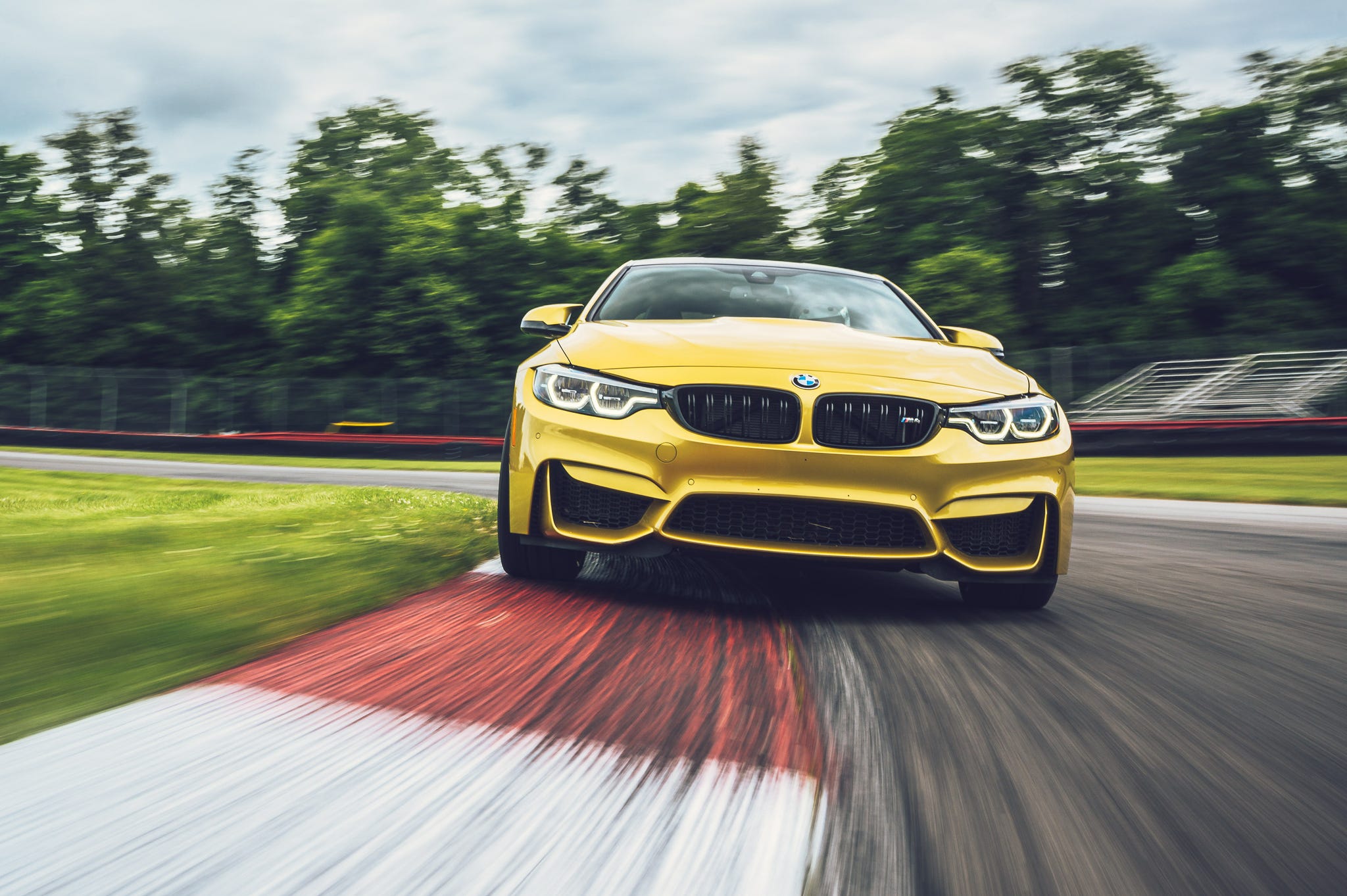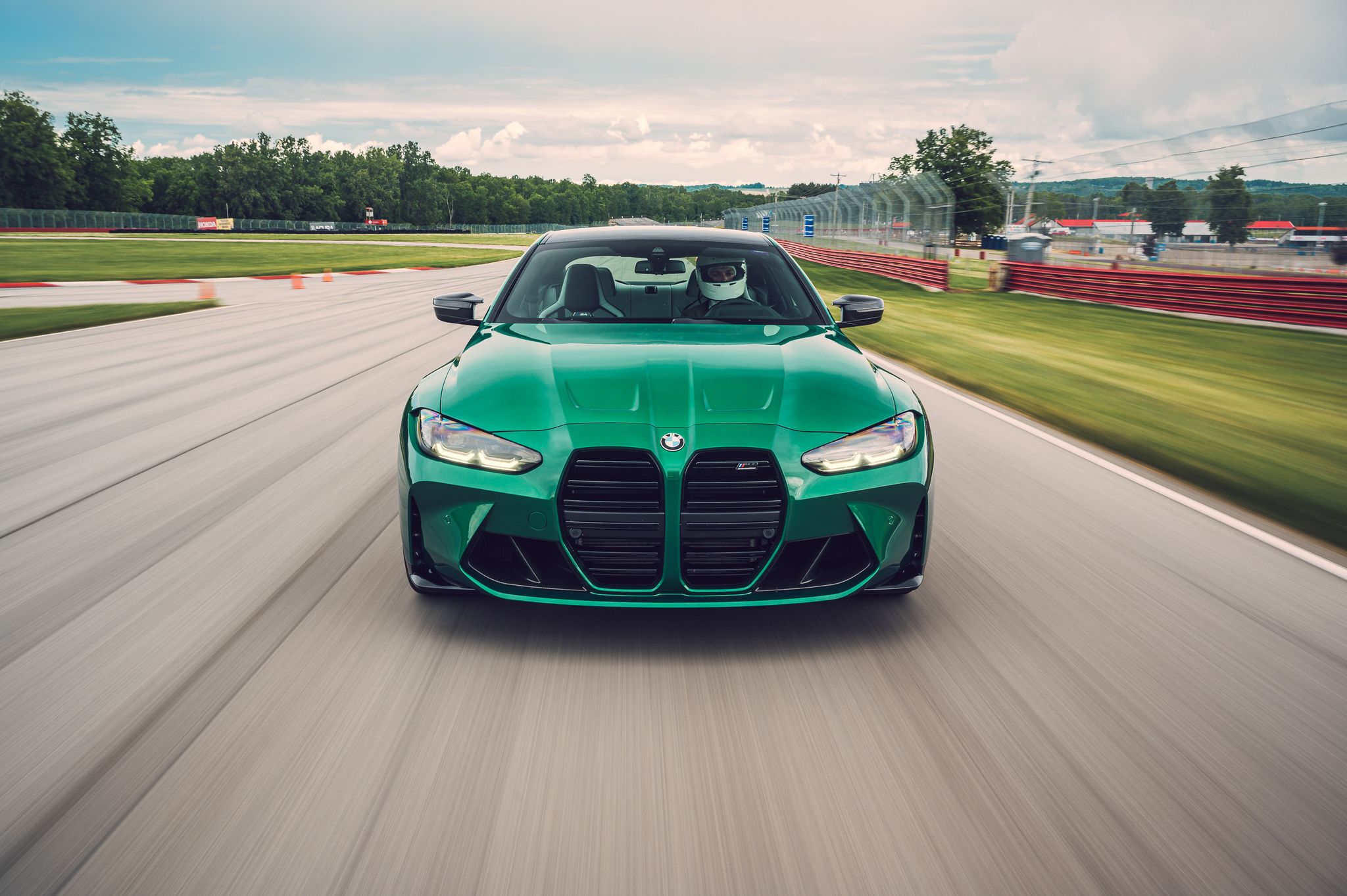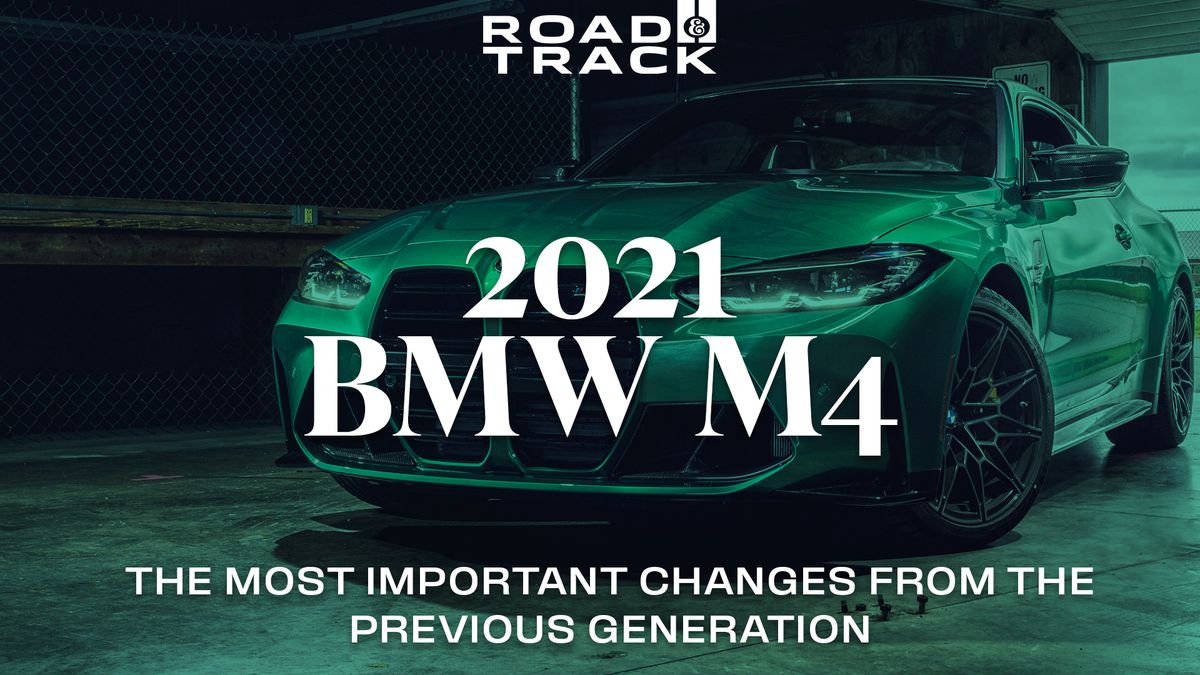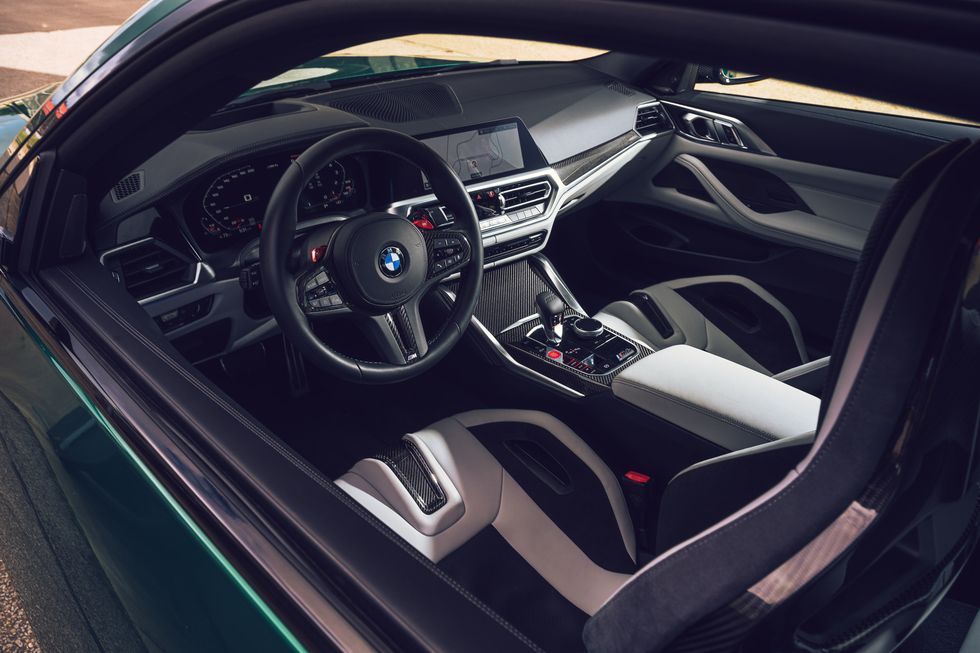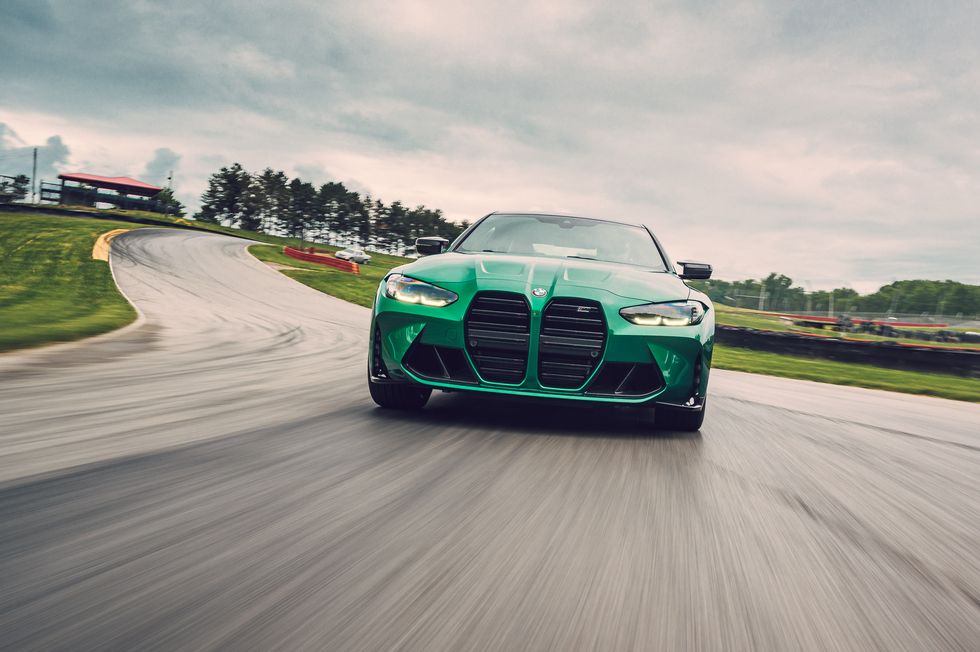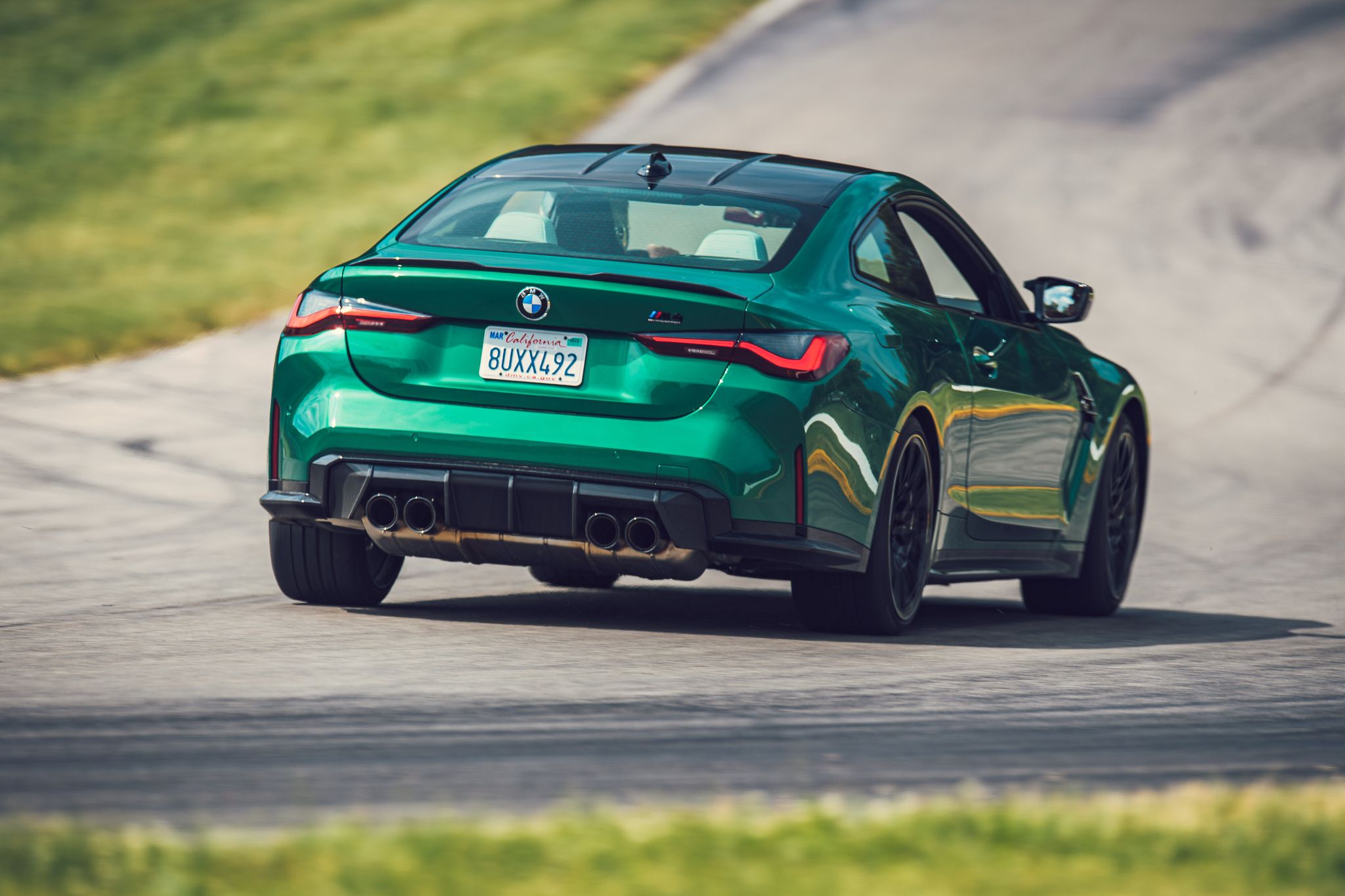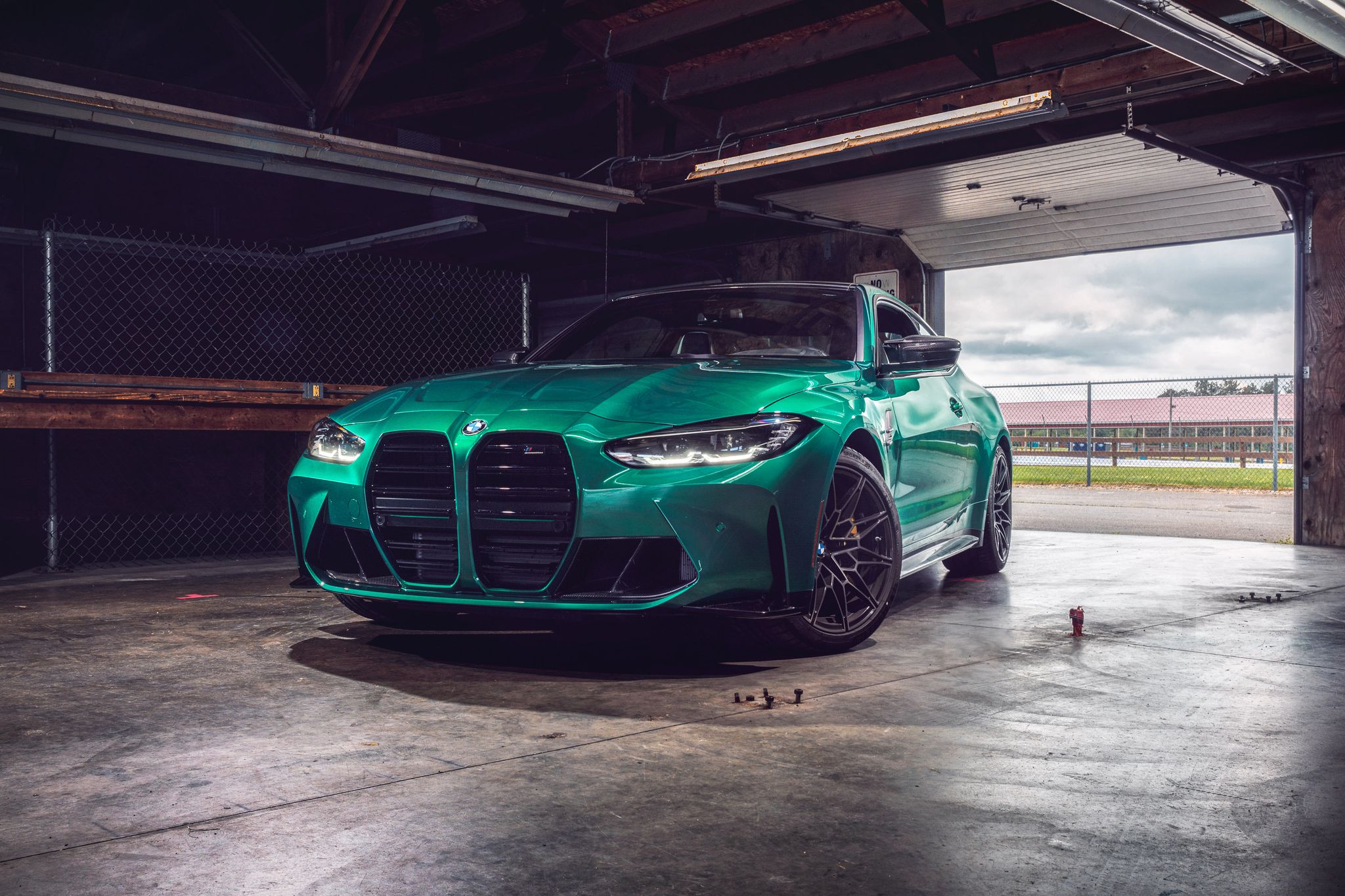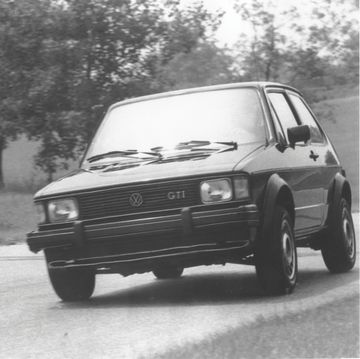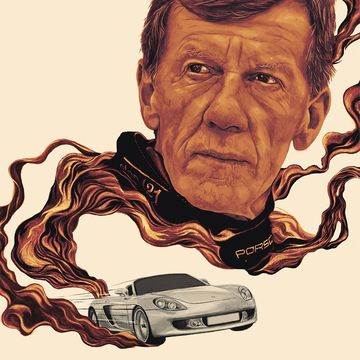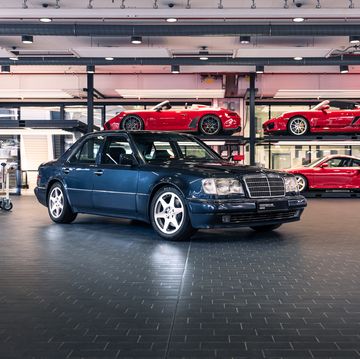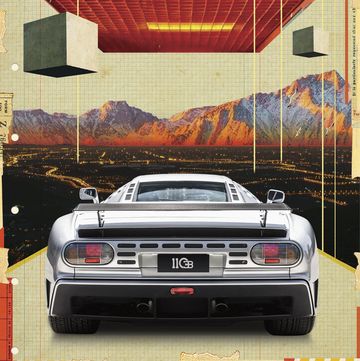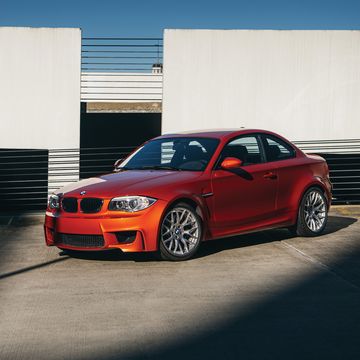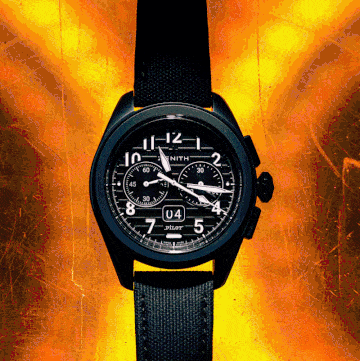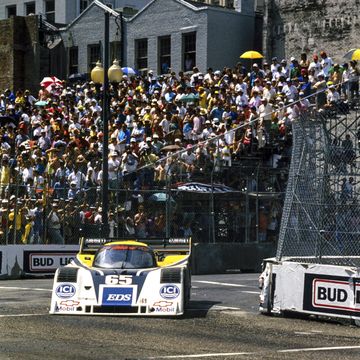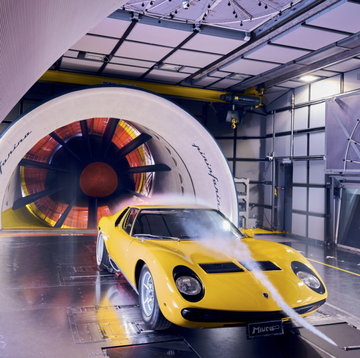The first BMW M3 debuted under the sparkling lights of the Frankfurt Auto Show in 1985. As Bavaria’s newest homologation racer sat gleaming on the show floor, did BMW’s own executives anticipate the passion this boxy sedan would inspire?
Heck no. But after more than thirty years of continuous production, the M3 feels as vital to BMW as the roundel itself. Now the introduction of the M3’s sixth generation offers an opportunity for reflection. So R&T gathered an ultimate low-mile example of each generation – from dealers, private owners, and BMW’s own museum – and lined them up nose-to-tail along Mid-Ohio Sports Car Course’s pit lane.
The track’s parade of curves offered something for each M3 to sink its teeth into. On a circuit that favors neither raw power nor nth degree adhesion, the intricacies of each generation emerged. After two days at Mid-O, and a few runs missiling along nearby backroads, our love for BMW’s purist driving machine was renewed and subtle nuances long ignored became obvious.
This Road & Track Generation Guide is less a sterile comparison test and more a misty-eyed celebration of Bavaria’s finest, which saw light at that Frankfurt show so long ago, then wormed its way into our hearts forever.
The E30 M3 Was Born a Legend (1986-1991)
Along this Murderers’ Row, the blocky first-gen M3 looks comically friendly. As if Spongebob bumbled into a prison lineup. And by modern standards, the first BMW M3 is gawky; an upright cab atop pillbox hips. Hindsight has been kind to this M3 though, known by its chassis code, “E30”. Because in 2021, only one word springs to mind when you see this car: legendary.
It took time to earn that reverence. This high-strung, high-revving, four-banger homologation coupe didn’t catch fire with the Eighties yuppie set – or enthusiasts – initially. BMW sold more than 19,000 E30 M3s worldwide. But just 5115 made it to North America during its run here from model years 1988-1991. While those production numbers more than satisfied the Group A homologation requirements, M3s didn’t exactly flood the streets. After all, that wasn’t the point. It was built to race, not as a status symbol among systems analysts. Then there was the price.
In 1988, R&T’s E30 M3 test car listed for $34,810, which is about eighty grand in 2021. It took a discerning buyer to go for the M3, which offered less refinement and two fewer cylinders than its brother, the 325i. Competitors like the Porsche 944 S and Mercedes’s übersedans offered stiff competition and more-prestigious badges too.
It was racing where the M3 earned its stripes. FIA’s Group A regulations, penned in 1983 to spur manufacturer involvement worldwide, stipulated that entrants must inherit the basic bodywork and engine from the road cars on which they were based.
So BMW flared their 3-Series coupe’s fenders to accommodate wider tires. They revised the sedan’s tail with a swept C-Pillar to move air more efficiently over that wide rear spoiler. The tweaks lowered the coefficient of drag but allowed more downforce. Every body panel on the car, save the hood, went under the knife.
And under that hood lurked a weapons-grade unit. BMW’s motorsports division cooked up the S14, a 2.3-liter, 16-valve inline-four that produced 192 horses for the US market. The mill buzzed and gnashed up to a 7250 rpm redline, fortified and spurred on by Bosch’s peerless Motronic engine management. In essence, the S14 is a chopped-down version of the M1 supercar’s big straight six. Righteous stuff. BMW dropped the S14 into the engine bay of its only-so-rakish sedan and went racing with Mercedes and Ford in its crosshairs.
The M3 made a habit of winning. Soon it was the winningest single touring car chassis ever raced. The car captured series titles in Germany, England, and Japan, and dozens of victories in hill climbs and one-offs worldwide. It was rallied to moderate success and maximum theater – an M3 wriggling down a slick back road is visual symphony. Eventually we enthusiasts caught on and the E30’s legacy snowballed.
Back here in 2021, we borrowed this Brilliant-Red gem from Enthusiast Auto Group – purveyors of earth’s best-kept M cars. This is a U.S.-spec car from 1989, with just 14,391-miles on the clock. A pristine example. The snowflake that began an avalanche.
At first the M3 seems simple. Humble even. The interior differs little from a standard E30. BMW preserved the same upright, Eighties seating position that aims your eyes downward, hood in full view. The interior’s switchgear, materials, door panels, and gauges are mostly identical to a standard 3-Series, save the indicator needles on the speedo and tach which are painted red. An oil pressure gauge replaces the fuel economy meter, but most of the cabin is bog-standard Bimmer.
The seats are fantastic: The bolsters on this low-mile car pinch the meat below your shoulders like an overzealous lineman’s bro hug, allowing your torso to wedge in as the car bends toward an apex. More lumbar support would be nice, but we spent four hours shuttling the car from Cincinnati up to Columbus and back and didn’t pine for a better throne at the end of the trip. And that comfort runs contrary to this car’s reputation.
People slag the E30 M3 as “buzzy;” a race-ready torture device you don’t bring home to mother. Yes, this car is buzzy. But that’s part of the car’s character. The engine turns over in a flash and settles into an eager hum. Even at idle, the four-cylinder emits a vibration that rumbles up from the seat back. Rest your feet lightly on any of the pedals, and that engine resonance nibbles your toes. Same thing with the shifter, which hums like a tuning fork, sending good vibes up from your fingertips clear up through your elbow. The whole thing feels alive.
That shifter has long throws in the US car. Euro-spec cars (like the later Sport Evo model that EAG leant us for consideration) were equipped with the Close Ratio 265 gearbox, a Getrag unit with tighter overall gearing. The action of that box feels more compact than the overdrive unit we received in North America and has a crunchier overall action. The CR265’s dogleg shifter doesn’t make huge sense on the road, as the clutch action and engine like a breath between gears during an upshift. But on a winding backroad or racetrack hairpin, that easy access to second gear pays dividends.
The M3 sings at Mid-Ohio with either transmission. Sure, any modern hot hatch (or Toyota Sienna) would walk the original M3 on Mid-O’s long straights, but those cars don’t cause joyous, stupid laughter to erupt from your helmet. The M3 revels in a touch of trailed brake, swaying into polite little drifts that raise your pulse but not your hackles. In the mid corner, the chassis’s neutrality shines, allowing precise braking, throttle, and steering tweaks. When you get it all right, this is one of the sweetest cars that’s ever pitched into a corner. Even more miraculous: you feel like you can’t get it wrong in an E30 M3. Such is the confidence it inspires.
Straightaways feel longer than ever but offer more of a chance to gulp down the S14’s induction howl (if you’re stood on pit wall listening to the car waaaaaaaahhhhhmp down the straights, even better).
That joy translates wholly to the road. Every input in the car is easy to work and perfectly weighted. There’s an economy of motion to operating the E30 M3 that’ll allow those inch-perfect slides or ten-hour cross-state road trips.
I cite that last bit with confidence. Because for me, the E30 M3 has always provided joy. With one of my first paychecks out of college, I bought an ‘88 M3 with 228,000 miles, a crumpled rear quarter panel, and no interior. They were that cheap back in 2011.
That glorious spell of E30 M3 ownership aligned with the few years on earth when I felt young, vital, and invincible. The M3 leaves a mark on your soul. Despite everything I’ve driven on this whirlwind journey at R&T, if you held out the keys to any other car and a ratty E30 M3 with torn seats and peeling clear coat, you’d hear a barking S14 just before I rocketed toward the horizon. It’s E30 M3 all the way down for me.
Sure, every generation of M3 has gone faster, become more livable and practical – a better car by every objective measure. But for me, this is a matter of the heart. Of intangibles. None of the later M3s offer the feedback and personality that makes the M3 so special to drive. Plus, the successor generations lack homologation roots and the narrative that comes with it.
If BMW had stopped here and left the M3 badge for dead, the car would still be carved onto automotive Mt. Rushmore. With plenty of hindsight, the E30 M3 feels like a perfect time capsule of Eighties verve, mixed with the last gasp of honest homologation glory. More than that, the E30 served as the perfect baseline for the legendary line of BMWs its nameplate would bear.
(Author’s note: Huge thanks to EAG for lending the car. And seriously, if you’re looking for a collectors-grade M car, start and end your search with them).
Enthusiasts Love the E36 M3 (1992-1999)
Easily overlooked, the second-generation M3 – identified by its chassis code, E36 – is now getting its due. Some enthusiasts fussed at the E36 M3 when it bowed in 1995, as BMW transitioned the M3 from a niche thoroughbred to a high-volume grand tourer. Other enthusiasts, like our friends at Car and Driver, named the M3 the best-handling car at any price in 1997.
And the E36 remains divisive. Blessed with handling, but cursed by a lack of power. In the US market, a 240-hp, 3.0-liter straight-six replaced the E30’s buzzy four-banger. That 3.0-liter was bored and stroked to 3.2 liters by 1996, but both engines borrowed bones from the 325i’s pedestrian (but inherently excellent) 2.5-liter engine. When ‘Motor’ is the middle name of your company, shouldn’t the compact flagship get more grunt?
European cars did. They received a different engine entirely, an exotic strain of German voodoo equipped with sophisticated heads, individual throttle bodies, and a more-advanced variable valve timing system (VANOS in BMW parlance). Late versions of that engine put down 321 horsepower.
So for decades the E36 went underappreciated in America. At times, even scorned. Enthusiasts couldn’t forgive the weak US-spec engines. Then there were the other nits picked.
People griped about the E36 interior. The plastics, which cover a vast swath of the console, feel toylike next to the E30. Cheaper. Even the 1000-mile example we borrowed from BMW’s own museum had drooping door panel fabric. Then there are the glove boxes which are affixed to the dash by string cheese, the brittle plastic clips that turn your door panels into mariachi shakers, thin leather seat bolsters, and fifty other frustrations.
The E36’s swollen four-spoke steering didn’t maintain the delicacy of the E30’s three-spoke design. There are far more buttons in the E36s cabin, and overall, this M3 is a bit less elegant. But that’s fine. Just remember that the E36 is less delicate than the E30 and that’s central to its charm.
There’s more heft to nearly every input on the E36; a reassuring quality in operation. This E36 M3 left the factory a shade over 3200 lbs in most configurations, nearly 400 heavier than the compact E30. You feel most of those pounds, whether it’s less jostle from a pothole or worse body control when tossing the E36 through a chicane.
The steering wheel requires wider elbows to knife the E36 into a corner, and the shift lever’s action feels notchier than the E30’s ‘box, but far more precise. The seats are great in this generation too with adjustment controls that all fall easily under your left hand, allowing manipulation of your seating position without higher brain function. When you’re trying to find that just-right setting during a warm-up lap at Mid-O, the quick seat adjustability is a godsend.
Some of these interior callouts sound like damnation by faint praise. Not so. There’s plenty to love. Because at some point, you turn the damned key.
The S50 settles into a glass-smooth, Bimmer-six signature idle. Prods at the throttle pedal reveal a free-revving engine that rasps and thunders up to a 6800 rpm redline. You sit low, wrapped bunker-like in the swept cabin, staring across that long hood. It’s a far more athletic driving position than in the upright E30, placing your hip close to the car’s center of gravity.
Rain came sprinkling down from low-hung clouds as I wheeled the E36 out onto Mid-Ohio’s curves. The fresh precipitation brought slick oils seeping from the asphalt, turning the track’s curves into banana peels. To pile on the mess, our E36 rode on the correct *cough* “period” tires, which you’d want on a museum piece. Less so on a track car.
Rather than diminish the M3’s spark, the ragged tires and oily surface highlighted the E36’s basic goodness. This generation’s longer wheelbase – paired with the low-grip track – emphasized this chassis’s penchant for slow, predictable rotation. The S50 engine wailed at each corner exit before the 5-speed allowed quick, precise shifts. It felt effortless to break the car into perfect rhythm.
Like the E30, the E36 never feels fussy or knife-edged. There’s always room to trim and adjust cornering attitude with plenty of slack in the line should you get the car out of shape. Some of that is a lack of power; It’s harder to get a car bent out of shape when entering a corner 20 mph slower than its successors. But mostly the E36’s compliant and competent chassis shines through. It deserves those best-handling laurels.
Our test model was a special “Lightweight” variant sold in limited numbers for the North American market (BMW sold more than 71,000 E36 M3s globally, but just 125 lightweights). The Lightweight shed pounds by swapping in simple, mechanically operated fabric seats for the heavy leather units. It also used aluminum doors instead of stock steel, ditched sound deadening in the cabin, and went without A/C and a radio.
The bright shining cherry on top was that glorious tri-color flag livery draped across Alpine White paint.
In short, the LTW is like any other E36 M3 but more. It maintains the E36s perfect 50:50 weight distribution between the front and rear, and in the slower corners at Mid Ohio you’d swear this car rotates around the cupholder under your elbow.
An LTW, however, isn’t the only E36 M3 worth savoring. Any version of the car will do -- even the first-time-ever M3 sedans and convertibles. Because the aftermarket latched on to the E36 unlike any other M3. Around 10,000 of units of M3 shipped to North America, nearly twice the number of E30s. That allowed E36 M3s to enter the secondary market carrying massive depreciation and little wear.
For about a decade from 2004 on, E36 M3s could be had in great condition for $5000. That baseline has risen to $10,000 for a driver-quality car, but you’re still getting a world of opportunity for that money. An E36 fits into your life like a good Labrador – asking for an ounce of attention but rewarding with absolute fidelity. And they’re still the most affordable M3 today.
I owned several E36s as a college student and young adult. My buddies and I tinkered with them endlessly. We raced them, abused them, and generally pushed our luck through every blind gravel corner that arced through Eastern Washington’s wheat country. These are cars you can really live through. They are stout and indefatigable things.
For me, that’s the E36s enduring legacy – it functioned as a gateway drug for so many Americans who would’ve otherwise missed BMW and landed in a lesser import.
That accessibility created a demand for go-fast parts, and a cottage industry catered specifically to this M3 chassis popped right up. Enthusiasts leveraged the E36s ubiquity – and considerable talents – to go road racing, rallying, and canyon carving. Even the neo-lowrider scene latched on to this chassis.
A few small tweaks can sharpen an E36 M3. A lighter exhaust, hotter camshafts and a less-restrictive intake manifold are de rigueur. Add to that some light engine tuning (usually in the form of a simple ECU chip), the right brake pads, and a set of springs. Now you’re dancin'.
Whether or not you tune the car up, the E36 is a paragon of design virtue, if not a leap in overall quality. The E30 is dorky and lovable in 2021. The newer M3s are menacing, bordering on tryhard. We may be at peak Nineties nostalgia, but for me the E36 wears Goldilocks proportions – angular yet smooth, compact yet swept. Purely handsome. For reliability, usability, and carefree bliss, the E36 is hard to beat – even among this field of all-time greats.
The E46 Is the BMW M3 Formula Perfected (2000-2006)
This is the zenith for many, the tippy top of M3 mountain. Because the third-gen M3 (code name: E46) is one of the last BMWs that feels old-school Bimmer where it matters. A naturally aspirated inline-six lives under the hood. There’s a hydraulic steering rack, and just-right proportions that act as the missing link between the E36s squared-off charm and the next M3’s bubble butt.
It’s very pretty.
The E46 marked a turning point when the M3 (and BMWs at large) transitioned from “chassis” cars, those that relished handling balance above all else, to “engine” cars with enough grunt to light off tire smoke from corner exit through the next county.
That’s thanks to the S54 engine, a dual overhead cam, 24-valve inline-six masterpiece that puts down 333 horses from just 3.2 liters. The mill is an ultimate incarnation of the BMW straight six – one of the greatest naturally aspirated engines ever built. You’d be tempted to call the engine joyous, because it brings giddy joy, but this is a menacing, angry lump of metal. A silky idle begets a throaty grumble flooding in the midrange. At full tilt, the S54 breaks into full chainsaw sonata until it bangs against its 7900 rpm redline.
There’s not huge torque here – just 262 lb-ft. at 4900 rpm – so you slam the throttle wide open and chase the top half inch of the tach. If that classic BMW soundtrack is what you’re after, there’s no better M3. Hell, there may be no better BMW.
At its launch we clocked the M3 from zero to 60 mph at 4.8 seconds. It sprinted the quarter mile in 13.5 seconds. With a curb weight of 3450 lbs, you couldn’t call it a featherweight, but there’s plenty of power to motivate the poundage. The chassis never feels overwhelmed. Plus the whole car seems to resonate with an angry, growling energy brought on by the S54.
In hindsight, the S54 feels mostly responsible for the S52’s pedestrian reputation in America – we didn’t understand how many horses our E36 was missing until the E46 brought the heat. And while the S54 brings more ferocity to this generation, the E46’s chassis isn’t any less usable. It does feel a shade woodier and less compliant on the road than an E30 or E36, so spend more time on race tracks.
The E46’s interior mostly returned to form in materials quality (just don’t ask the owners of E46s about the clips holding their doors together). This M3 moved back to a more elegant three-spoke steering wheel. Brushed aluminum trim surrounds the shifter and door handles and there’s swaths of the stuff strung across the dash like tinsel on a tree. It’s nice to touch, but feels dated.
The cabin maintains the E36’s lowdown driving position, but reveals far less of the E46’s snout. The car is equipped with another great pair of seats. They’re pliant, roomy enough for your hindquarters, but equipped again with bulging lumbar pads to keep your shoulders in check. Pedal placement feels perfect here, even if the wheel well offers less usable foot room than either the E30 or E36 (something to consider for those of us with size 11-or-larger feet).
There’s a tailored quality to this interior, enough contrast between material tones to keep your interest, but tempered by a businesslike layout. It’s tight, but not suffocating. “Focused,” maybe. Because the E46 preserved that economy of form and motion that each previous M3’s interior brought to the table.
That’s of use here, at Mid-Ohio, especially through the track’s undulating middle section, which pitches the car’s nose like a sine wave as you snake through. The E46 danced on its tippy toes through Turn 5 – neutral as Switzerland – even as the corner crested and chucked the car toward its nervous, downhill exit. The E46 simply stuck in everywhere, with 255/40ZR18 rubber out back that gripped Mid-O’s tarmac far tighter than the previous M3s. That increased grip allows less play than previous M3s, but chasing the S54’s redline is its own brand of intoxication. And listening to that straight-six note doppler off the countryside is pure bliss.
The price of entry for these Bavarian gems is rising. You’ll pay a premium for a well-kept car with six speeds and three pedals. The clunky Sequential Manual Gearbox (SMG) cars will suck up your time or burn all your money. Keep an eye out for torn or cracked rear subframes, or budget for a weld-in reinforcement kit to solve the issue. S54s are known to eat rod bearings with heavy use. Oil analysis and/or a preventative fix takes care of the issue. With those key fixes in place, you’re left with perhaps the platonic M3; That raging Bimmer six hidden behind a finely tailored suit of armor.
Is this the M3’s zenith? Well, it’d be hard argue against the E46.
The E92 M3 Sounds Like Screaming Thunder (2008-2013)
I scribbled down one note after a dozen laps in the M3’s fourth iteration. “F***ing phenomenal.” Then I underscored it with a half-dozen scribbles. Maybe we stacked the deck; This Lime Rock Park Edition M3 (one of 200) added a lightweight titanium exhaust, a few carbon-fiber flourishes, and a coat of Fire Orange paint to the original recipe. But it’s telling that BMW didn’t touch the engine on its most track-focused E92.
We’ll cut to it: This is the best-sounding M3 ever built, a tidal wave of induction whomp crashing over Mt. Exhaust Burble. Throughout the day, every head on pit lane snapped to attention when that V-8 howl echoed from the far end of Mid-O, more than a quarter-mile away. And though the 4.0-liter V-8 makes just 414 horsepower to motivate 3650 lbs., the engine’s shout is as subtle as an air raid siren.
It’s a special engine, the S65. And one that’d be impossible for BMW to replicate under today’s regulations, which smother the good noises for the sake of efficiency. The 4.0-liter reaches redline and peak power together at a dizzying 8300 rpm. So you back into Mid-O’s slower corners at the top of second gear rather than lugging from apex to track-out in third. On a track, this engine is absolutely ripping more often than not. And that’s a not-so-subtle quality that emphasizes the playfulness in the E92’s chassis.
Under braking and in corners, whether fast or slow, this M3’s chassis never betrays. Rather, it throws an arm around your shoulder as you lean further into the car’s talents. So many fast cars have that same quality right until the moment they decide to go all Hannibal Lecter on your face. That genuine friendliness, we discovered, was one of the intangibles that defines the M3 nameplate. Even as every generation went faster than the last, they never abandoned the desire to turn workaday white collars into race-crushing heroes.
The E92’s Dual Clutch Transmission (DCT) was another surprise. I expected a clunky, jostling experience, but the DCT doesn’t feel its age on upshifts, snapping them off at 8000 rpm without drama. But on downshifts, especially with the front end loaded at that crucial intersection between braking and turn-in, the DCT hesitates, stuttering as it drops down into third and especially second gear. It’s not frustrating, necessarily, because you know the gear is on its way and that it’ll arrive by the time you need to put power down. But the transmission shows its age at this track, especially next to contemporary DCTs and the supremely calibrated 8-speed ZF ‘box in most modern Bimmers.
Still, the E92 feels equally alive on a backroad, unhampered by the DCT (and don’t forget you can find these with six speeds and three pedals). The seats are comfortable enough for a long haul but your ears and the seat of your pants never escape that animated V-8 bzzzzzzzz through the titanium exhaust. This is the most well-rounded M3, a bottle rocket fresh from boarding school. The whole experience is wrapped in handsome, forward-looking sheet metal.
Inside, the E92 M3’s wide, bezeled, and recessed infotainment screen sits essentially in the same place as the modern cars. There’s a swooping line that frames the dashboard and of course there’s the iDrive knob protruding from the center console. Only the instrument gauges nod to the past, seemingly carried over from the E46. But not much outside the infotainment interface feels especially old in this car that’s heading for a 15-year anniversary, because BMW landed at this design and started iterating. Does that mean BMW has leaned too hard on this layout over the past decade, rather than pushing forward with some imagination? Please debate.
But we can’t fault BMW. The E92’s proportions have looked fresh since the day that sheetmetal was stamped. Why not iterate from a surefire hit? The used market had its say on the matter, too. Few used E92s ever fell below $20k dollars (unlike every M3 generation that came before), and the good examples are appreciating steadily.
To that end, the E92 is a modern classic; a can’t-lose collectible proposition that never got cheap enough for the secondary market to thrash. The facelifted "LCI" cars (circa 2009), with their updated infotainment system and revised headlights are just modern enough for a daily driver in 2021. The E92 M3 is an athletic ‘Bahn stormer, totally at home at Mid-Ohio. And the sounds of the V-8 M3 are literally awe-inspiring. That’s God’s own brass section blaring from its tailpipes. “F***ing phenomenal” seems just about right.
With F80, the M3 Leaped Into the Future (2014-2018)
On the heels of the E92, the fifth-gen M4 arrived in 2015 like a Teutonic Terminator; chiseled, menacing, gorgeously muscled. And do note the name change. Henceforth, the fifth-gen sedans would bear the M3 name. The coupes would take “M4”.
It was a divisive change. The M4 badge had no history attached to it; Many felt that BMW were chasing Audi’s nomenclature rather than following their own path (the A4 sedan and A5 coupe were mechanically identical but separated by two doors). Splitting segments into ever-finer pieces wasn’t a new idea, but it didn’t feel genuinely BMW. Frankly, we are still barely coping.
At the track way back when, we clocked a 12.3-second quarter mile, 3.9 seconds to 60 mph, and measured a curb weight (3595 lbs.) lower than its predecessor. That’s a first for this bloodline. Huzzah!
Again, the engine is the star; a 3.0-liter twin-turbo inline-six putting down 425 horsepower and 406 lb-ft. Redline lives at 7600 rpm. The engine, called the S55, features a dyno chart with power curves flatter than a pane of glass. As peaky and loony as the V-8 mill was, you can’t argue with the raw effectiveness of two snails cramming buckets of atmosphere into a Bimmer six.
I’ll never forget my first drive in the M4, some time in early 2016. I set off from our Ann Arbor offices in driving rain. The engine settled into a guttural burble at idle and I held the traction control button to disable the driver aides. It was a matter of habit I’d developed with every other BMW in my life.
I loafed along in the car through a soggy city intersection just as the street light turned yellow. When I poked at the gas, the S55’s glut of mid-range torque kicked right back, and the M4 nearly pirouetted into oncoming traffic. I tiptoed the car the rest of the way home, my palms slick with anxiety, and haven’t touched the traction control button on a roadgoing BMW since. Lesson learned.
The S55’s power came on so hard and so early, it’d catch drivers out, especially if the traction control wasn’t there to reign them in. Sometimes you want to let your hair down a bit but don’t necessarily want to YEEEEEHAAWWWWW through the drive-thru. So the M4 broke that harmony between chassis and engine. The F82 was a stallion with wide flanks and flared nostrils – you couldn’t just reign it in.
With the later competition-package cars – like the one we borrowed for Mid-O heroics – BMW tamed the loss of grip when the S55’s fat midrange hits. Some combination of suspension fettling, tire compound, throttle mapping, and wizardry harnessed the available power. It was a welcome change, especially as the M4 sat idling in pit row, pointed toward a soggy race track.
You can recognize the M4 by its idle alone. A low, surging, throaty burble scores the lowest portion of the S55’s rev range. Mostly it sounds like someone stuffed a tube sock up the M4’s tailpipes.
But as soon as you roll on to Mid-O’s front straight, the engine goes mecha-symphonic, spraying the sound of turbo compressor whine through the cabin, layering that high note over acres of straight-six howl. There’s far more noise here than you thought possible from a boosted mill. Can the engine’s soundtrack compete the atmospheric M3s? Nope. Is it prominent, ferocious, and singular among the range? Yes.
And when you hit those first two straights at Mid-O, it’s not the difference in noise but the contrast in speed that shocks you. The M4 wipes the floor with any of its predecessors, where lap times and spec sheets are considered. There’s huge grip available from the front end as you dive toward the apex of Mid-Ohio’s cambered Turn 2 and the M4 seems to build speed with supercar pace after you exit each corner.
Note that after early headaches, the M4 has become one of the most common track tools for weekend warriors. The S55 has proved responsive to modification, robust, and reliable. Any M3 owner looking to extract maximum speed from their HPDEs (without the need to wave by another Porsche 911) should look no further than the F82.
Still, many of M3 hallmarks went missing.
Classic BMW steering feel – that alluring, legendary, tactile gem – is absent here, replaced by an electric rack that takes effort but never reveals intricacies like the old stuff. And we’ll never understand the angle of the steering wheel vs. the pedal box and seat, with cants the driver’s torso askew, rather than keeping both halves of the driver aligned with the car’s longitudinal axis. Then there’s the tray of buttons for adjusting the engine response, chassis compliance, and electric steering sensitivity via buttons in the console. Who asked for these settings? Why? Thankfully it’s easy to land on a setting you like with enough time, but even the presence of those buttons feels finicky bordering on irksome.
The interior offers through lines, namely the look and feel of the interior touch points like the steering wheel and shifter. There are upscale touches embellishing the interior, but few distractions, as ever.
Whatever the strengths or faults we find with the F82’s driving experience, the car is a triumph of modern design. Those voluptuous hindquarters are connected by a swooping waistline to a masculine snout with wide kidney grilles that emphasize the low, taut presence of the M4. When you stand back and take it all in, the whole car looks like it was draped in silk. Several of R&T’s younger editors picked the F82 out as the best-looking M3. In time, the rest of the staff might come around.
The F82 is as relentless as the T-800 when loosed on a racetrack, but dusted with less charm than any M3 before. Maybe another decade of hindsight will bring our opinions around, or maybe we’ll just appreciate the M4 for the massive leap forward that it was. This is the M3 that faced the future, a super coupe with gorgeous lines, all-day comfort, and the twin-turbo six that made our palms sweat.
The G82 M4 is an Effortless Beast (2021-?)
The sixth-gen BMW M3 arrived, as is tradition, drenched in scorn. The main gripe: That schnoz. The kidney grilles went Dalí on the G82, drooping to cover the car’s entire snout. If history is any indicator, the indignation will persist. But then we’ll spot M4s all over, normalizing the design. In six or seven years we’ll forget the fuss entirely, just in time for a new M4. Rinse and repeat. (Proof: Remember the first M3 endowed with eight cylinders? Unthinkable! And then the M4 went turbocharged? Heresy!).
Thankfully you can’t see that snout from inside the car. A forty minute interstate blast from hotel to the racetrack allowed us to soak in the M4’s massive charms. This is by some measure the most comfortable, serene, and isolated cruising experience among any of the cars we sat on Mid-Ohio’s pit lane, including the photo rig, a Toyota minivan. Whether isolation and serenity should have any place in an M car is a nebulous debate. BMW owners voted with their wallets long ago. Now the M3’s mission feels a lot closer to the M5’s mission but with less sheetmetal (and, of course, a grille that could swallow two Cockapoos at once).
That dedication to creature comforts is underscored by a vibrant new interior, which represents a quantum leap forward in design. The intricate carbon bucket seats are lined beautifully with contrasted stitching and covered in pillowy leather. When you drop into them, they seem to yell with affirmation, “YOU ARE A SPECIAL PERSONAL INJURY LAWYER”. And it’s not just the seats, but considered fabric choices, a more sophisticated dash display (the tachometer and speedo are analog, thankee BMW), and a sense of imagination draped across the interior surfaces.
If the interior’s “wow” factor is considered, the M4 finally feels like a legitimate Porsche 911 killer. Much more special, in fact, when you compare this interior to the monotone interior in most 911 trims. And that comparison holds up on the race track as well. This is no doubt faster than a base Porsche 911 at Mid-O, and it'll keep a Carrera S in its crosshairs here. I’d put money on it.
That’s thanks to improved front-end grip that leaps out at you from the very first hard corner. Bill Auberlen, BMW racing driver of the highest caliber, explained that you should wind the car in for a late apex through Mid-Ohio’s turn two, a long and critical hairpin that leads on to the track’s longest straight. By the end of that straight the M4 could reach well into triple-digit speeds, so nailing turn two was imperative.
The problem was at the apex. At turn two, right as you ask the tires for their last percent of available grip, the pavement cambers away. That pushed the nose of every other car wide. Except the G82 M4. On my first try navigating that corner, the M4’s nose stuck right in to hit the apex sweetly. That was on cold tires. With successive laps, I cooked into the corner hotter and hotter, but the M4 had enough grip on hand to kiss that apex every time – reliable as the sunrise.
No other M car has sharper front end with more immediate turn-in. From the wheels, tires, and chassis, BMW has nailed the ratio of the steering rack here (despite their foibles in the feedback department, modern BMWs have nailed steering accuracy absolutely). There’s not a huge amount of feel from the wheel, though we’re marching back in the right direction with this car (compared to the F82). Still, nibbling the outside of those TKT/TK/R19 front tires against the curbing proved intuitive, even if those tactile qualities we love in early M3s – like the E30s buzzing, chattery steering wheel – were left behind generations ago.
In pit lane, I tracked down TC Kline, owner of a BMW suspension tuning firm of the same name. Kline’s shop has been tweaking suspension on the 3-Series for decades. Mostly, I wanted to compliment Kline – no parts catalog has hacked my bank account balance to bits like his. When I walked up, Kline had just unfolded himself from the M4. He had been lapping Mid-O like he owned the place. It was an inspiring sight.
Kline surveyed the car with a furrowed brow. I asked him when we could expect a catalog thick with aftermarket suspension kits for the G82 M4? There’d be a new generation of M3 owner out there with high credit card limits and the need to tinker, surely. “Maybe never,” he replied with a frown. The statement hung in the air like a guillotine.
By Kline’s estimation, and our own performance data, the G82 M4 is more expansive in its talents than any M3 that came before. But that should be obvious by now, an entirely logical conclusion. Except with this one, Kline mused, it’s different.
The car is wildly competent at both snatching fast laps and ironing out rutted gravel roads. Its systems are so thoroughly integrated, swapping out suspension components would likely throw a digital wrench into the mix. Could the aftermarket actually improve this car?
Then again, how many other M3 owners had the same thought over all these years, “BMW couldn’t possibly outdo this, could they?” And like clockwork a new car to arrives to raise the bar.
Our day at Mid-Ohio ended at dusk, sunset painting the horizon like a flare. The bustling pits went silent. Our staff slumped into chairs for the first time in two days and watched as the cars eased silently back on to one trailer or another. Lining six generations of M3 up on pit lane, evaluating them on merit and with the benefit of hindsight, brought new perspectives. We found the line’s evolution perfectly traced the sports car buyer’s shifting priorities. Over decades, the M3 morphed slowly from hard-nosed racing instrument to leather-lined battle axe, each generation so evocative of a moment in enthusiast culture.
Every new generation of M3 faces the same criticism from the hardcore enthusiast, condemned as softer than the last, less focused than the one which preceded it. And when you sit them next to each other, it’s hard to ignore that the M3 has grown larger and heavier with time. It’s also hard to ignore the numbers. BMW’s flagship has gone faster, accelerated quicker, and stopped shorter with every iteration. In that way, the six M3s revealed another through line.
BMW postulates changes in buyers’ tastes with every successive generation of M3, then puts those changes into production. It’s brave stuff, really, not the cynical cash grab that enthusiasts would make those changes out to be. Because the rest of the market – and the minds of BMW’s most-devout zealots – always race to catch up with the newest M3. But those hearts and minds always come around eventually, just in time for BMW to unveil the next generation. So it goes.
And despite its ever-evolving form, the M3 has remained deeply desirable. It’s less stuffy than a Porsche, more functional than a Corvette. You’ll see fifty M3s at a track day for every Audi S4 or Mercedes sedan. In that way, an M3 – brand-new or ragged with abuse – is a secret handshake, a membership card for those in the know.
It’s always hard to tell where the M3 goes from here. Will it go electric? Maybe hybrid. Something else? While we can never predict the direction progress will take us, we're certain the BMW M3 will be there to lead the way.
